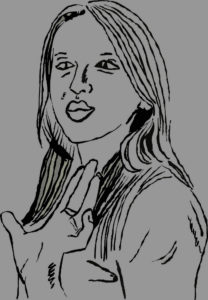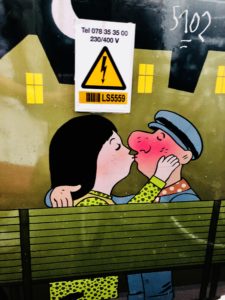FIRst week in the netherlands (7.1-7.8)
2018.7.1 Day 1: Random walk in Amsterdam, Flower markets, Vondelpark, Dutch pancake bars
2018.7.2 Day 2: Van Gogh Museum, Boat tour on canals, Coffeeshop, Local bars
2018.7.3 Day 3: Scavenger hunt in Amsterdam, Vondelpark
2018.7.4 Day 4: Train from Amsterdam Central to Utrecht, Utrecht University, proposal at Dom Church, Dinner by canals
2018.7.5 Day 5: Rijksmuseum
2018.7.6 Day 6: Train to Delft, Hall of Prinsenhof, Old & New Churches, Local nightclub
2018.7.7 Day 7: Stedelijk Museum, Sex Museum, Red Light District
2018.7.8 Day 8: Arnhem’s Open Air Museum
2018.7.1 Day 1: Random walk in Amsterdam, Flower markets, Vondelpark, Dutch pancake bars
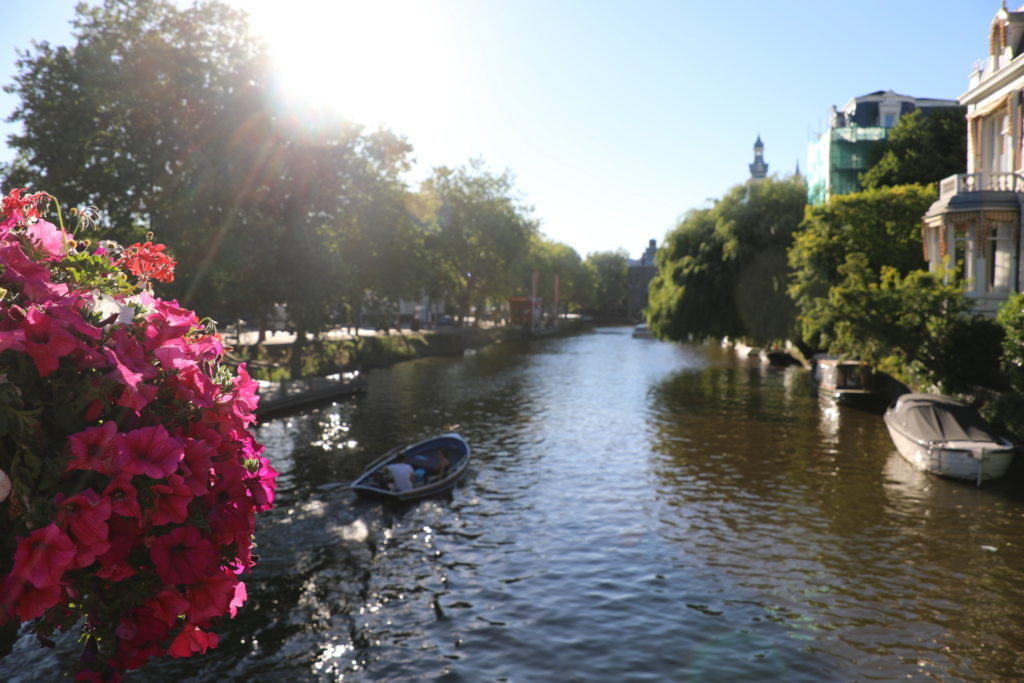
I simply don’t know where to start! Amsterdam — a fantastic city where you can daydream even at night!
I just went for a walk by myself in the Vondelpark right next to the hostel. It was 10:30 at night. But the sky is still lit up. The park was so infused with the energy from lively laughter and a romantic air, that it really felt like 4:30 in the afternoon.
Young people sat or lay down in circles on the grass, talked and laughed. Bikers passed by me in various speeds and colors of shade. Some put on headphones and dropped both hands as if immersed in their own rhapsodical worlds. Some turned their heads to a lover or friend, merging their cycling paths with each other’s. An old man in red Hawaiian shirt rode by me slowly and stopped in front of a trash can to collect wastes. Among all this vividness there sat a loner under the tree, daydreaming of a world unknown to all that were passing by. Do Europeans all live an epicurean lifestyle?
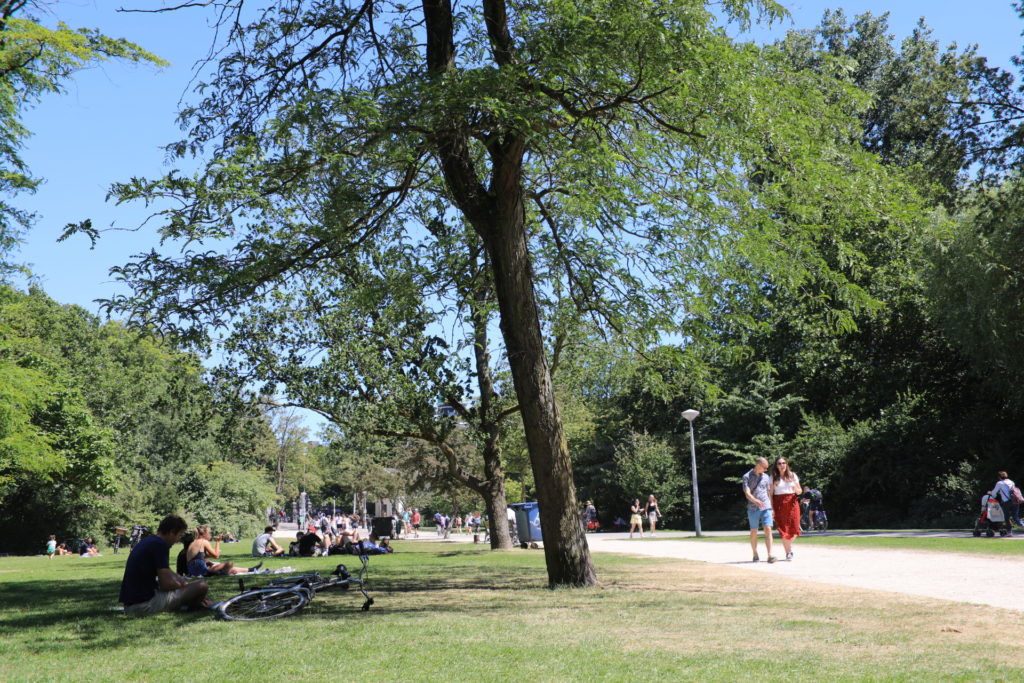
Two girls were sitting on a bench and talking. One of them was smoking a cigarette. I walked up to her to borrow a light, and then sat down on a bench on the other side of the road. But I had so much to write on my journal notebook that I turned a blind eye to the burning ashes dropping down on my leg. I wanted to describe the styles of clothing and acting there, only to discover amazedly that everyone had their own unique dressing or acting style. It is impossible to characterize them with any specific adjectives. Yet I managed to come up with three big words to hint upon my vague impression of their appearances —simplicity, sharpness, personality.
I arrived here today around noon, so I was quite jetlagged. But the chilly night air sobered me up and made me so happy. Even the birds were still chirping. I walked back to the hostel after a while, asking myself how I might capture all that I’ve seen and felt within.
But I should briefly summarize what I have done today. After taking a taxi to the hostel and checking in my baggage, I went to Leidseplein for lunch at a pancake bar, which I chose simply because it had the most people eating outdoor. I also sat outdoor and finished a huge savory pancake with salami, bacon, Dutch old cheese and mushroom. Besides the pancakes, stroop waffles are also a must-try in the Netherlands.

We’re going to stay in the Stayokay Hostel near Vondelpark for the entire time we spend in the Netherlands. After returning to the hostel to check in, I met a lot of interesting people in the program, all of whom are ardent travelers just like me. We talked for a long time and went out together for a walk and dinner.
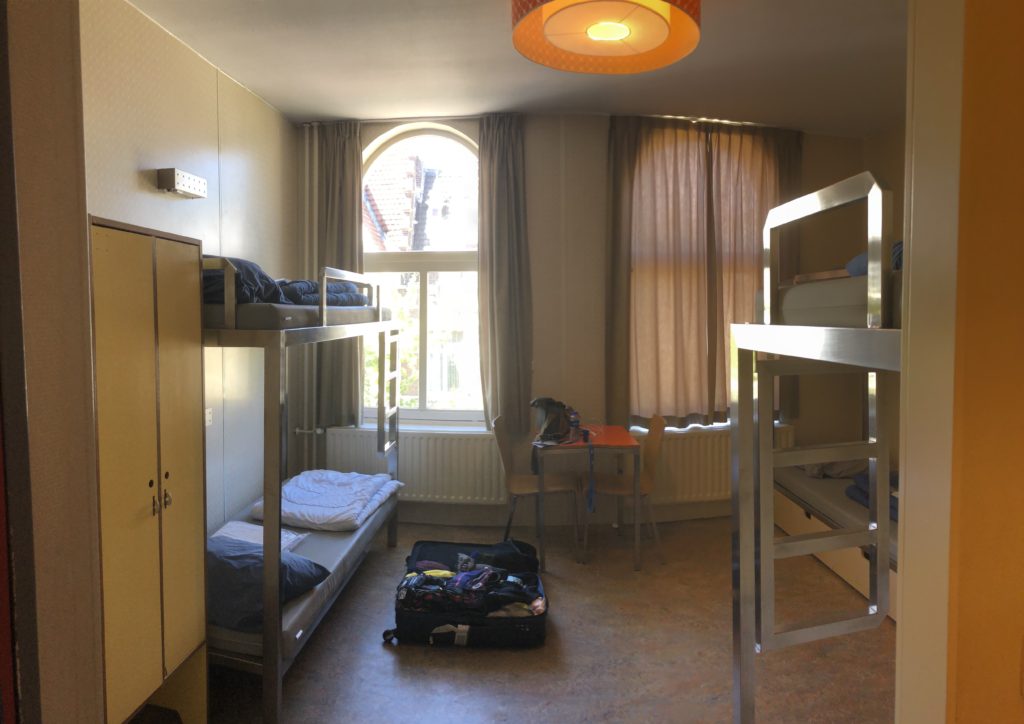
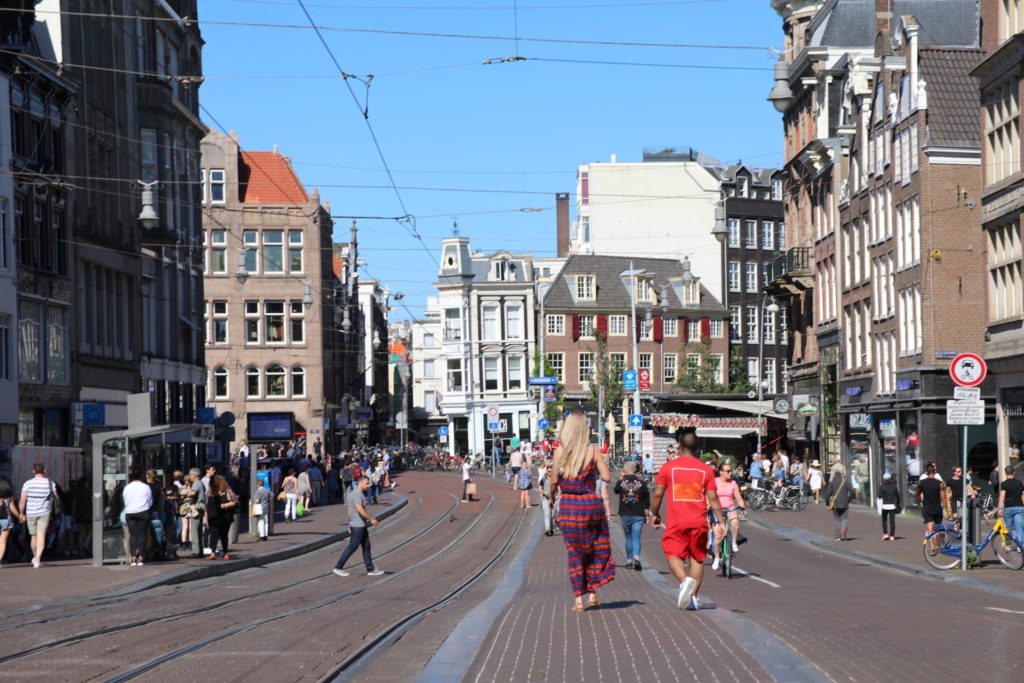
We went for a walk in Leidseplein and then across the canal rings. We fell in love with the flower markets by the canals, where dry flowers were hung above our heads. It was still early afternoon. But there were already people coming in and out of the coffeeshops, where soft drugs are legally sold.
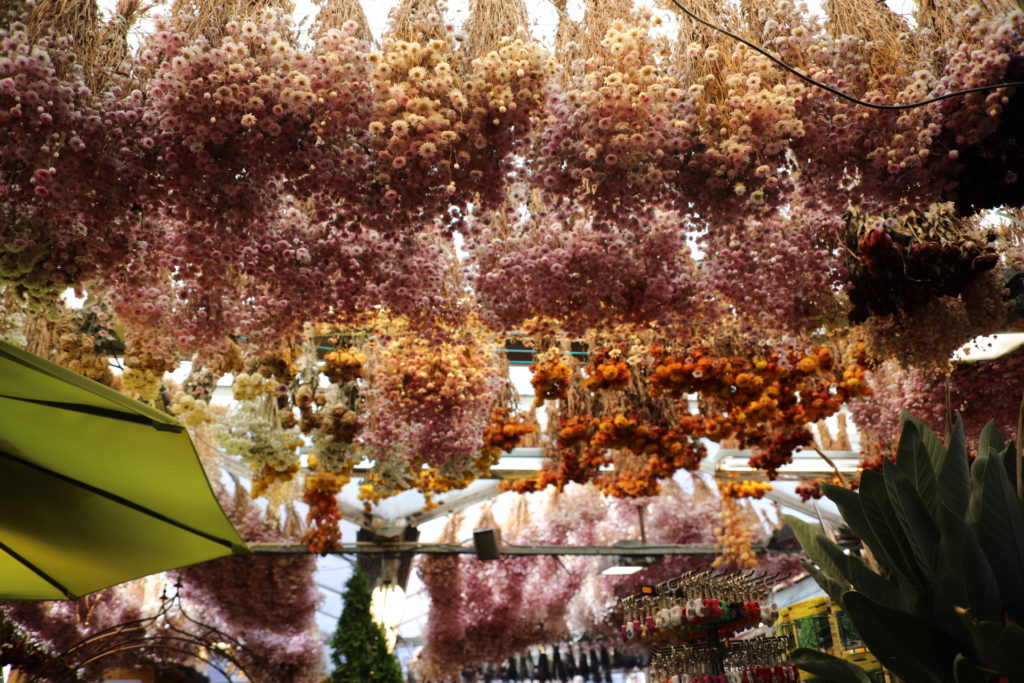
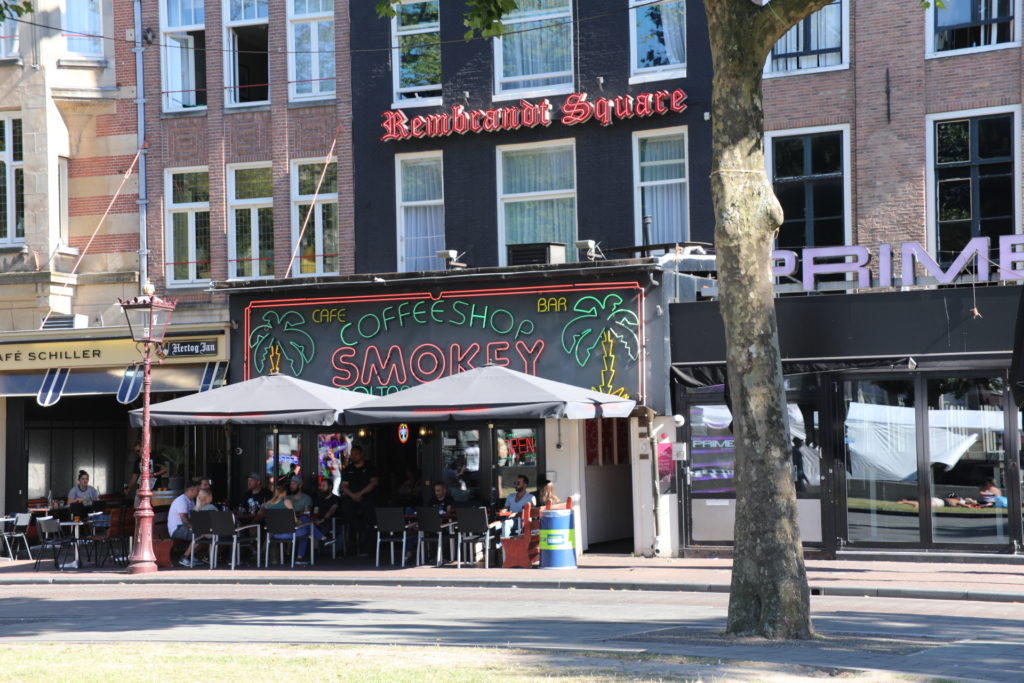
Later, we chose to eat at a bar called De Nachtwacht, where we could join in watching world cup Russia vs. Spain. The Russians won against the Spanish on penalty kicks. The Russians screamed and jumped, wrapped their bodies with Russian flags, drinking hard liquor straight from the bottles and dancing in a circle with strangers.
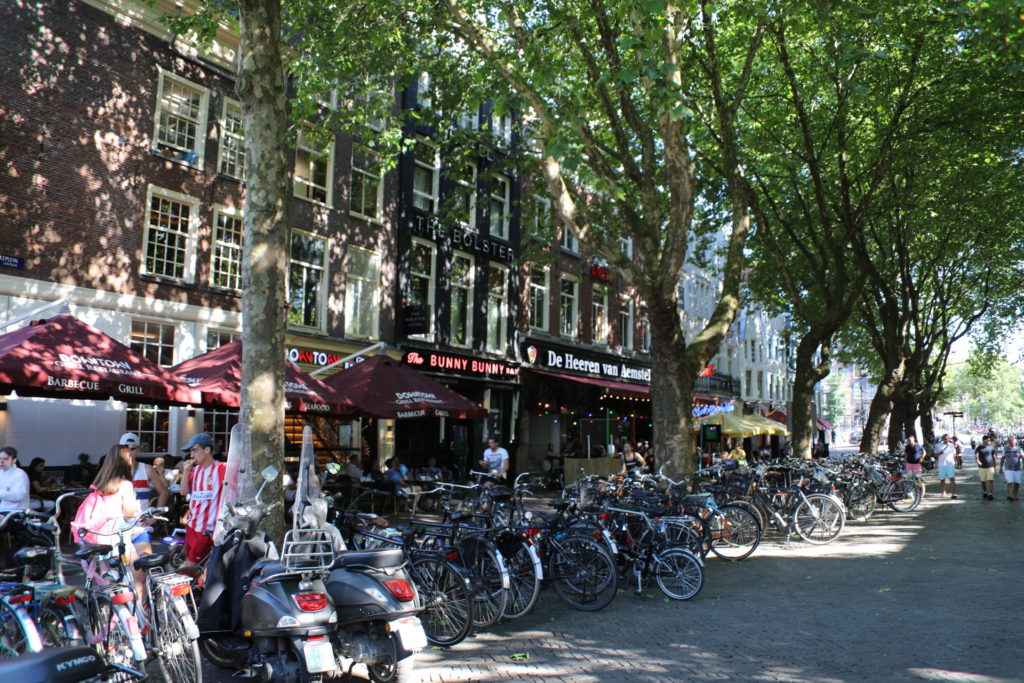
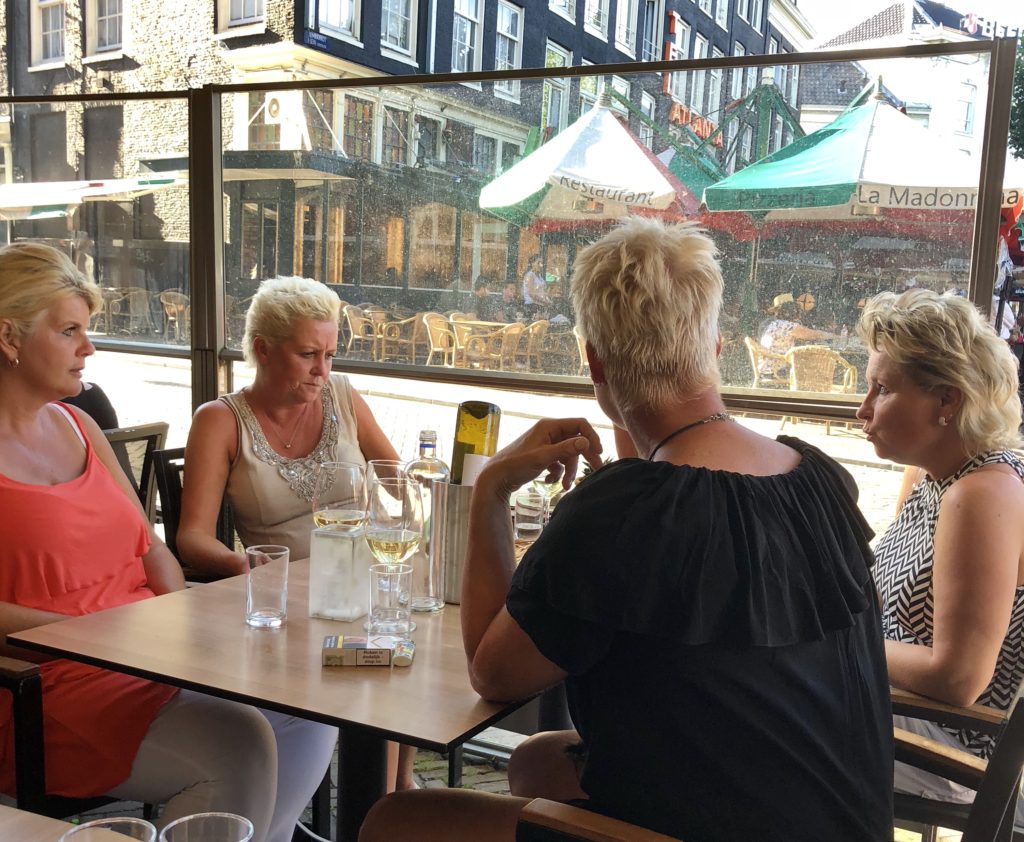
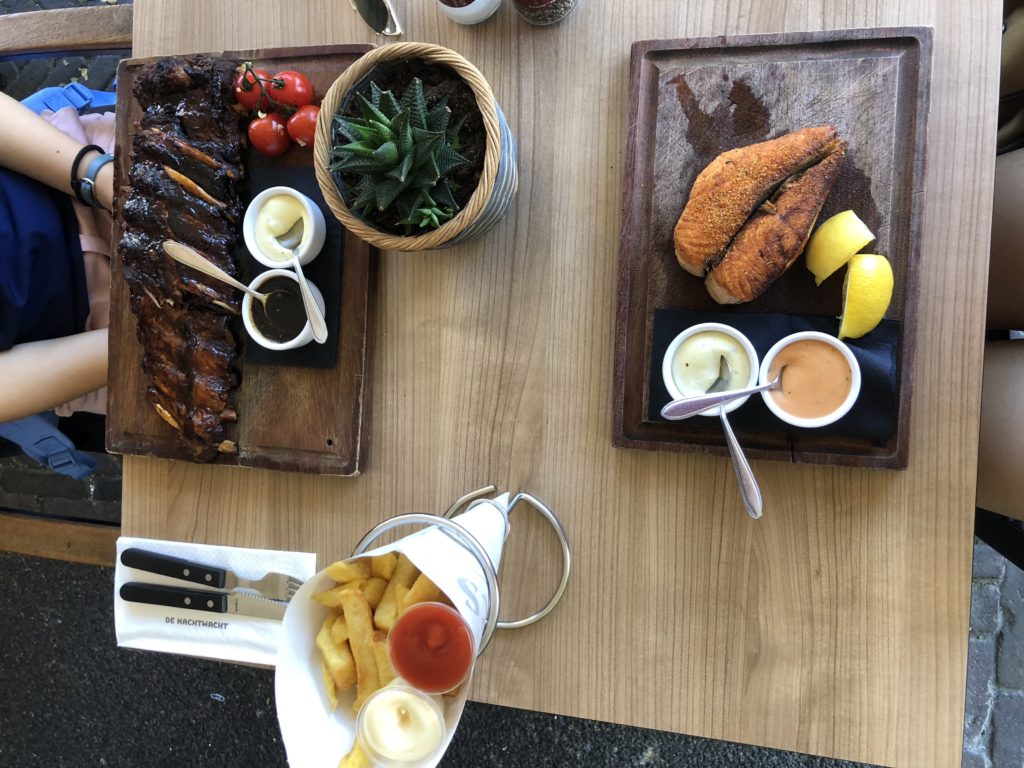
We ran into the other girls after dinner and walked all the way to the “I Amsterdam” sculpture next to Rijksmuseum. A bunch of drunken men whistled at us and catcalled with dirty words in Spanish. But the sunlight was strong enough to blind me from the indecency.
After returning to the hostel, a friends and I went to the hostel bar and watched a bit of Croatia vs. Denmark, until she left to go to bed. I stayed to finish my journal and then went for the walk in Vondelpark, as I described earlier.
It’s almost half past twelve. My eyes are closing involuntarily now. Goodnight Amsterdam!
2018.7.2 Day 2: Van Gogh Museum, Boat tour on canals, Coffeeshop, Local bars
A few days before coming here, I watched the fully painted animated film Loving Vincent. Van Gogh had always been a blurred and massified image in my mind. His paintings commercialized and overpopularized, I had been reluctant in learning more about him. But the film led me to perceive him no longer as a mad artist that cut off his ear and shot himself — but as a person struggling, seeking, and striving through life to reach the stars in his own night sky.
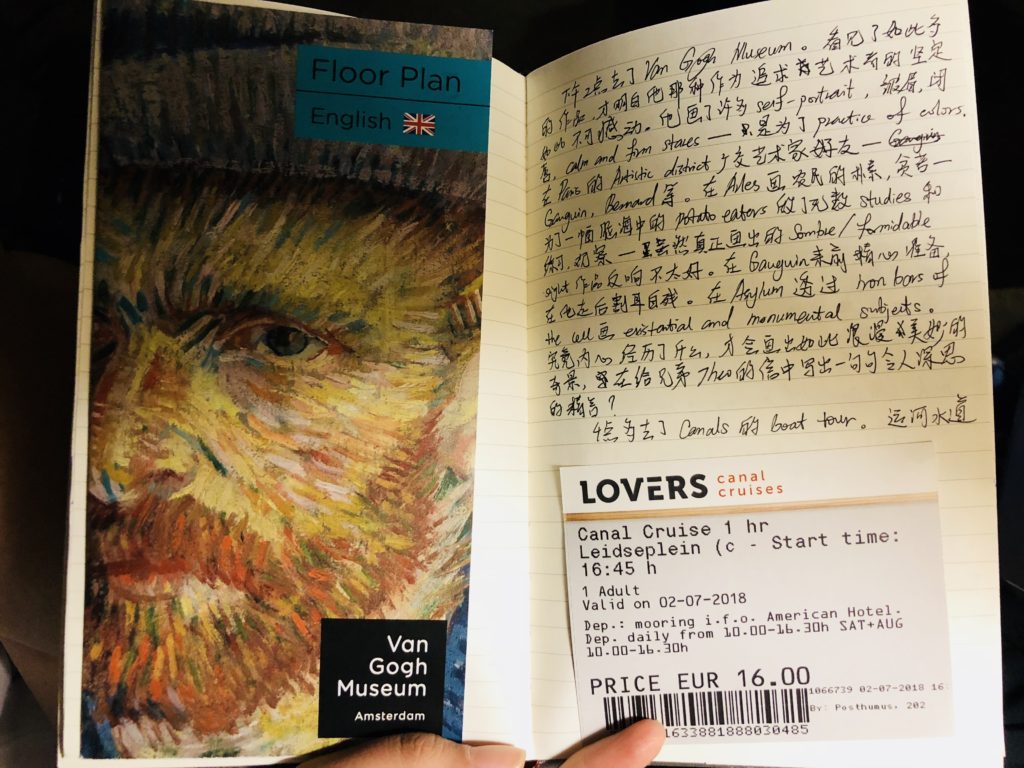
Upon observing his works in the Van Gogh Museum, what struck me most was his perseverance and diligence in the pursuit of art. Contrary to the common impression of him as an impulsive and very emotional artist with wild imagination, he actually worked in a highly systematic and well-considered way. Unlike his friends Gauguin or Bernard, he did not base his work on imagination but rather reality. He has painted over 40 self-portraits mostly as a method of introspection and practice with colors. “Painted portraits have a life of their own that comes from deep in the soul of the painter.” He wrote in a letter to his brother Theo.
He was not a solitary artist. In the cafés of Montmartre in Paris, he became intimate friends with Gauguin, Bernard, Pissarro, de Toulouse-Lautrec and others. They often exchanged letters and sketches of paintings, influenced greatly by each other’s art styles.
But van Gogh struggled in all his relationships. Van Gogh was passionate and serious about art. He always argued with other painters about their works, alienating those who had contradictory opinions. After Gauguin became tired of arguing constantly with van Gogh and walked out of the yellow house, van Gogh cut his ear and offered it to a prostitute in a local brothel.
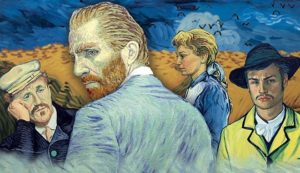
He also had a catastrophic love life. He was attracted to women in trouble, such as his widowed cousin and an alcoholic prostitute. But these women always left him heartbroken and smashed his romantic vision for their love into pieces. Why is it that a romantic lover is always a failed lover? I wonder.
I was also awestruck at the paintings he produced during his final years at the asylum in Saint-Rémy-de-Provence, including “Irises” and “Starry Night.” It seemed to me that, it was behind the iron bars of his cell that he saw most clearly the nature of life. It was after his body lost its freedom, that his soul was finally liberated into the starry sky.
Meditating upon all of these, I couldn’t help but wonder what he must had felt after being broken by life, and what had motivated him and made him so firm and stubborn in his ideas and pursuit of art.
I think the following quote from van Gogh’s letter answers my question.
“What am I in the eyes of most people — a nonentity, an eccentric, or an unpleasant person — somebody who has no position in society and will never have; in short, the lowest of the low. All right, then — even if that were absolutely true, then I should one day like to show by my work what such an eccentric, such a nobody, has in his heart. That is my ambition, based less on resentment than on love in spite of everything, based more on a feeling of serenity than on passion. Though I am often in the depths of misery, there is still calmness, pure harmony and music inside me. I see paintings or drawings in the poorest cottages, in the dirtiest corners. And my mind is driven towards these things with an irresistible momentum.”
After the Van Gogh Museum visit, we went to the Lovers Boat Company for an one-hour canal cruise.

Amsterdam is famous for not only the canals lined with all kinds of boats, but also the narrow houses that line the 17th century canal rings. Most of them have very consistent architecture styles, from the typical gables to fully decorated neo-classist front. The simple bricks are usually in some tints of earth tone, with identical wide windows lined in black or white. The differences lie in the rooftops’ design, where the architects founda way to express themselves. Because of the impracticality of the narrow and steep staircases, there is a metal hook at the top of each building for hoisting heavy items in and out through windows. The oldest and most magnificent of the houses are located on a triad of beautiful canals that encircle the city’s historic center—Prinsengracht, Herengracht and Keizersgracht.
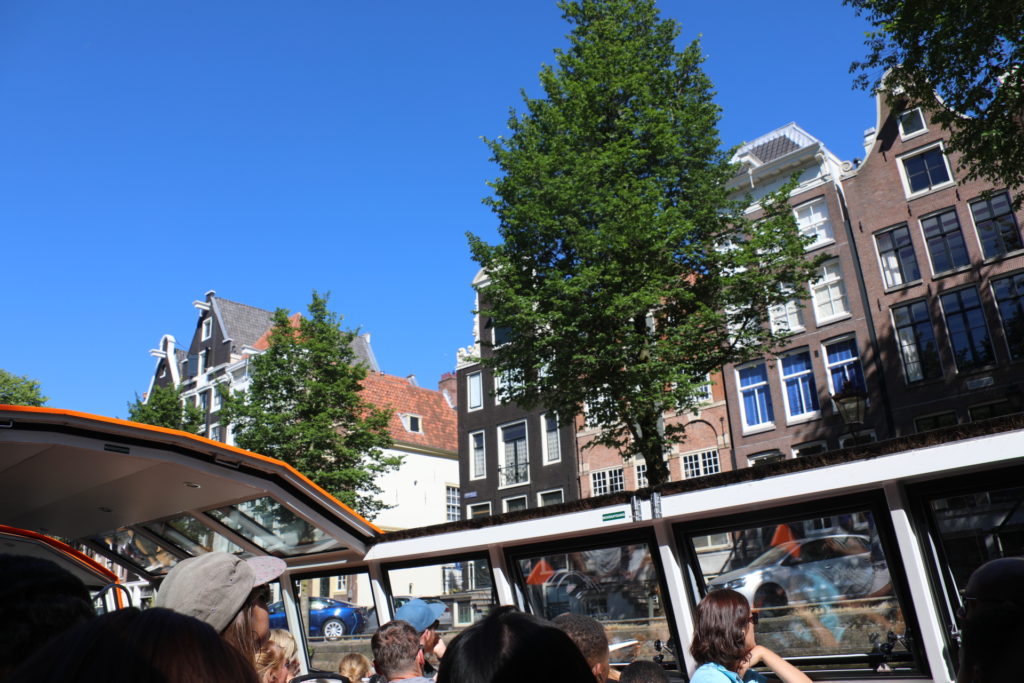
But that is certainly not all of it! Included in this iconic view are the Dutch people — who are spending their time idly together along the canals. Some of them were sitting together on the edge of the road, swaying their feet above water. The smoke of their cigarettes rose up slowing under the golden sunlight, flicking like gold dust in the air. Some of them were hippy-looking loners, sitting cross-legged and meditating motionless in front of the fast passing bicycles, cars and trams. Some of them were friends. Some lovers. Some are parents and children laughing happily together. Some drinking beers around a table and chatting with all kinds of hand gestures.
And they were doing all these things on a Monday afternoon at 5pm! Quite an unthinkable thing in Berkeley.
This reminds me of two of the Dutch mentalities the professor taught us this morning — Gezellig (having company with a pleasant, cozy atmosphere) and Gewoon (being ordinary and proud of it).
The Dutch is gezellig in a way that they’re always in each other’s companies. The general idea of togetherness is realized through time spent catching up with friends, cuddling with loved ones, or even dancing and singing in circles with strangers. It is a sense of individual positivity and warmness that one shares with others. If you take a stroll in Vondelpark, you will see what I mean.
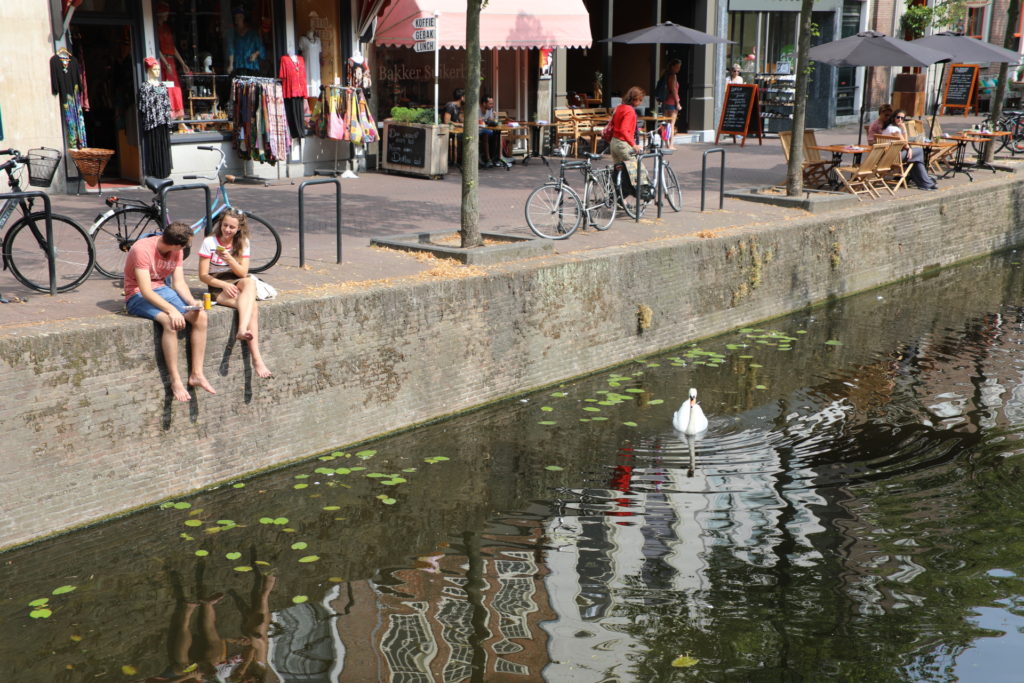
Also, according to the lecturer, unlike in America, being average is the standard in the Netherlands. The Dutch don’t want to stand out, but instead want to be just like everyone else. Efforts at standing out and proving oneself may be seen as an annoying display of arrogance. In their eyes, all are on an equal level.
For example, the Dutch use a ten-point grading system (1-10). As long as the students get above 5.5, they can pass the course. And as long as they passed the course, no one will ever care about their actual grades — not even the employers. Therefore, there’s no need to excel and not much academic stress. Sometimes Dutch people even act against proving oneself to be more excellent than others — for instance, people don’t put titles on their business cards. If anyone does, the person will be considered rude and arrogant. Dutch people are proud of being ordinary and equal to all others — an amazing quality that will remain incomprehensible to people like us, living and striving to excel in a very competitive environment like Berkeley.
Are these mentalities the reasons why they are able to have a moment of peace with themselves at any time of the day, without being bothered by the inner anxiety and stress we feel constantly in our own countries?
All of the scenes I’ve illustrated above gave rise to a sense of timelessness. One simply cannot feel the passing of time in Amsterdam.
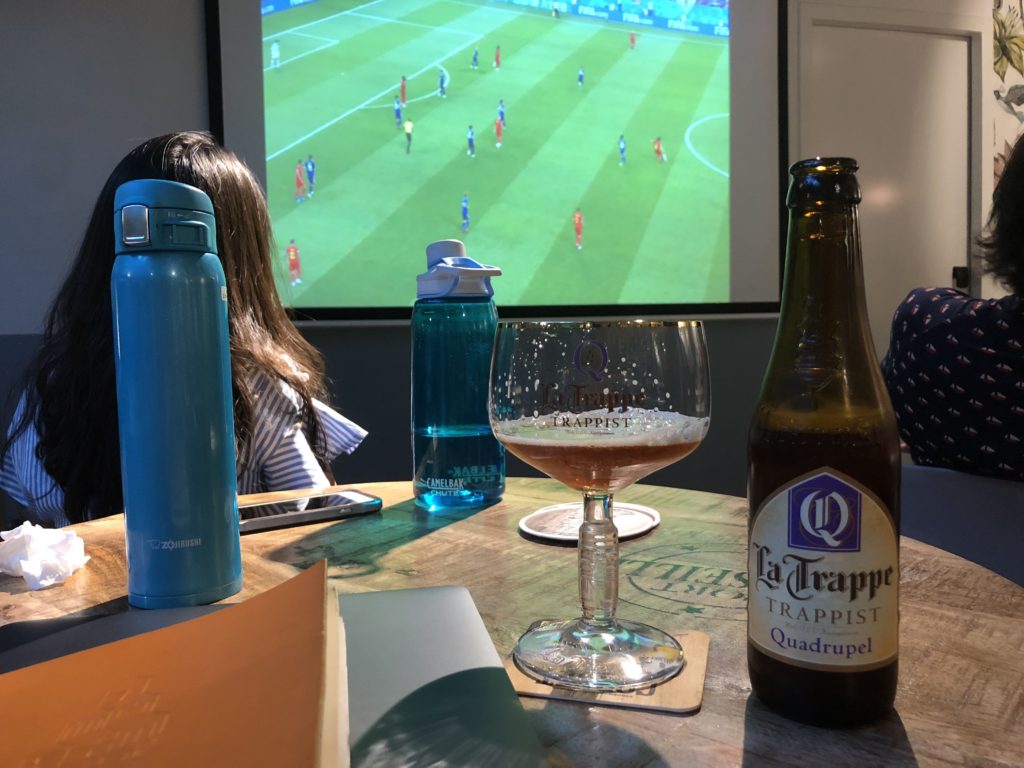
After dinner, I sat at the hostel bar and watched Belgium vs. Japan. When the Japanese miraculously got its second goal against Belgians, I was the only one screaming happily in the bar. All the Dutch people around me covered their heads and groaned in pain. It was in such an European place, listening to world cup commentary in Dutch and sitting among all the Europeans, that I became much more self-conscious of my identity as an Asian woman. But at that moment I didn’t feel lonely at this awakening self-awareness, because I was witnessing an Asian soccer team fighting with blood, sweat, and tears to subvert the negative stereotype people have in mind of Asians’ athletic capabilities. Two other Asian friends also came to join me. Japan eventually lost 2:3 to Belgium. But I was still very proud!
Some of us left the hostel at around 10:20pm for clubbing. It was getting super chilly outside. But I was so excited that I didn’t even bring a jacket with me. At first we walked to the club they found, but it was closed. There was only a middle-age woman sitting on a chair, singing romantic songs in a flirtatious way. We then walked along the Leidsestraat street, searching for unknown destinations. The sky has already darkened and the Amsterdam nightlife has officially started.
We entered The Otherside, a coffeeshop (a special place in Amsterdam where cannabis are sold and consumed). The owner was a man in green shirt, who looked as stoned as the customers smoking. But most of us didn’t buy anything and we left shortly.
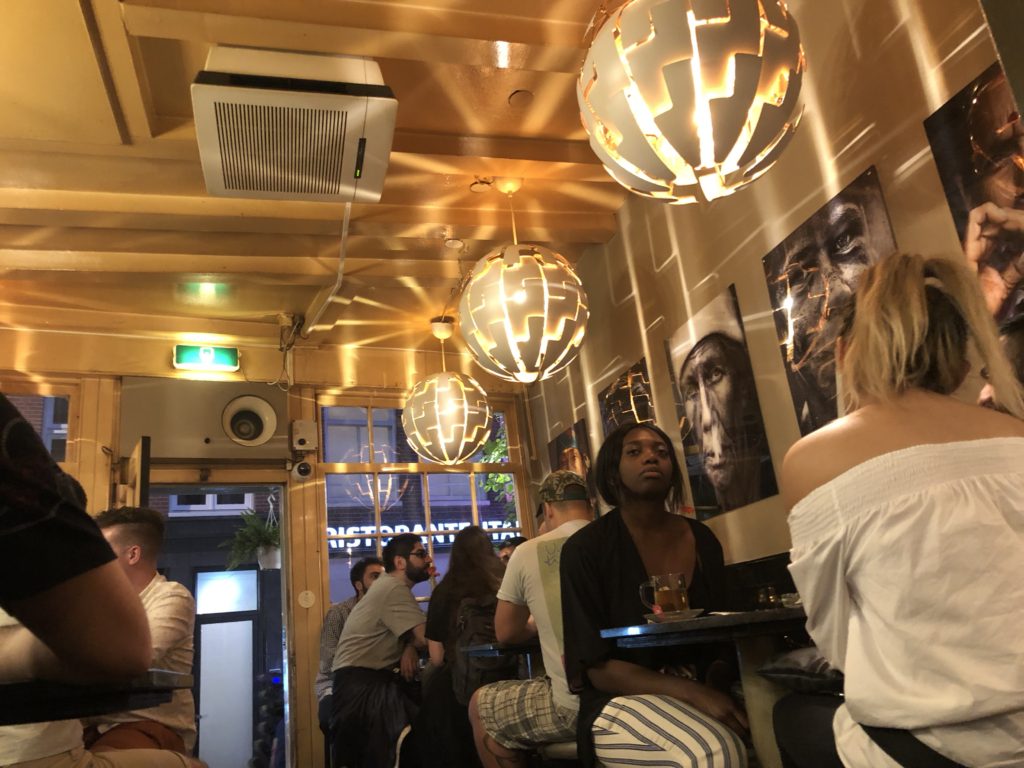
As we were walking aimlessly, looking for bars or anything fun, I realized that the Amsterdam School architecture at night looked very different under the dark sky. Lost of its solemnity at daylight, the buildings reflected shades of neon lights from the bars or coffee shops nearby. They transformed from serious-looking gentlemen of the past, to coquettishly smiling women of the modern age, flirting and bewitching young nightlifers like us.
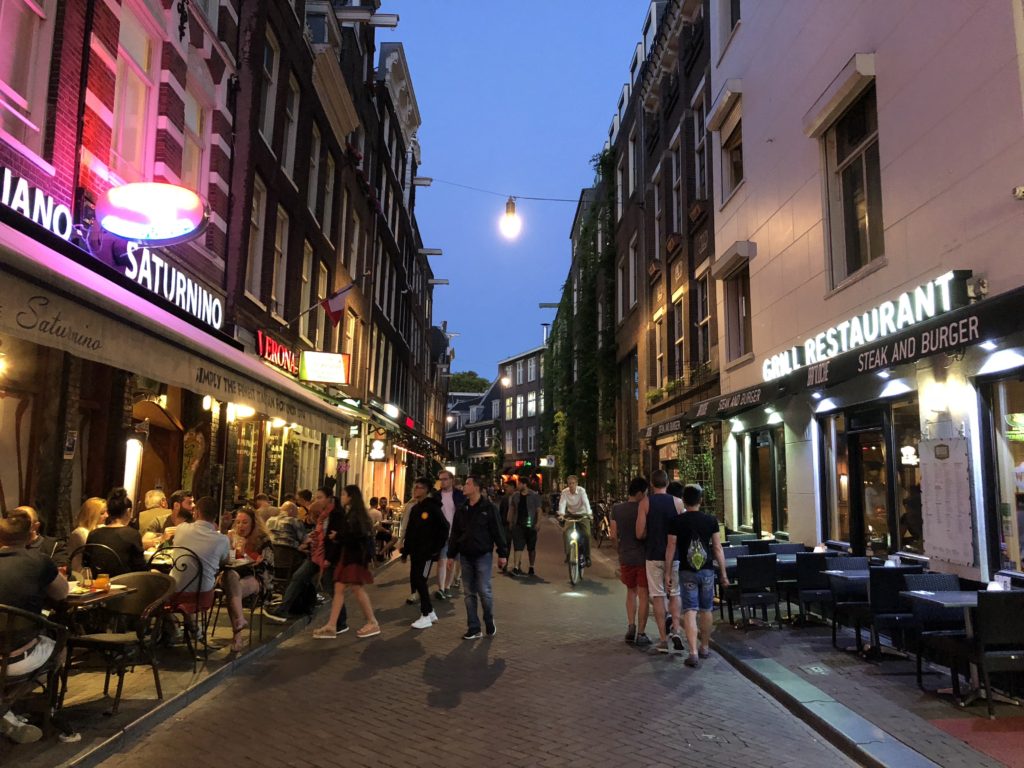
The five of us went in the Taboo bar at last. We got Tequila shots and beers and gin. Together we cheered for the gezellig (conviviality) of our summertime in such a fantastic city. As we drank more, the subjects of our conversation got as wild and reckless as possible. Sex and love did not become taboos in the Taboo bar. On the contrary, it was a place where social taboos and conventions were overthrown, where the mind and body were liberated from social pressures. But the actual words coming out from our mouths did not matter then. It was the collision of voices, of unrestrained body languages, of accidental eye contacts that really captured this vibrant social scene of young people. We are young, and we are just dashing about recklessly in all directions to fight our ways out in life.
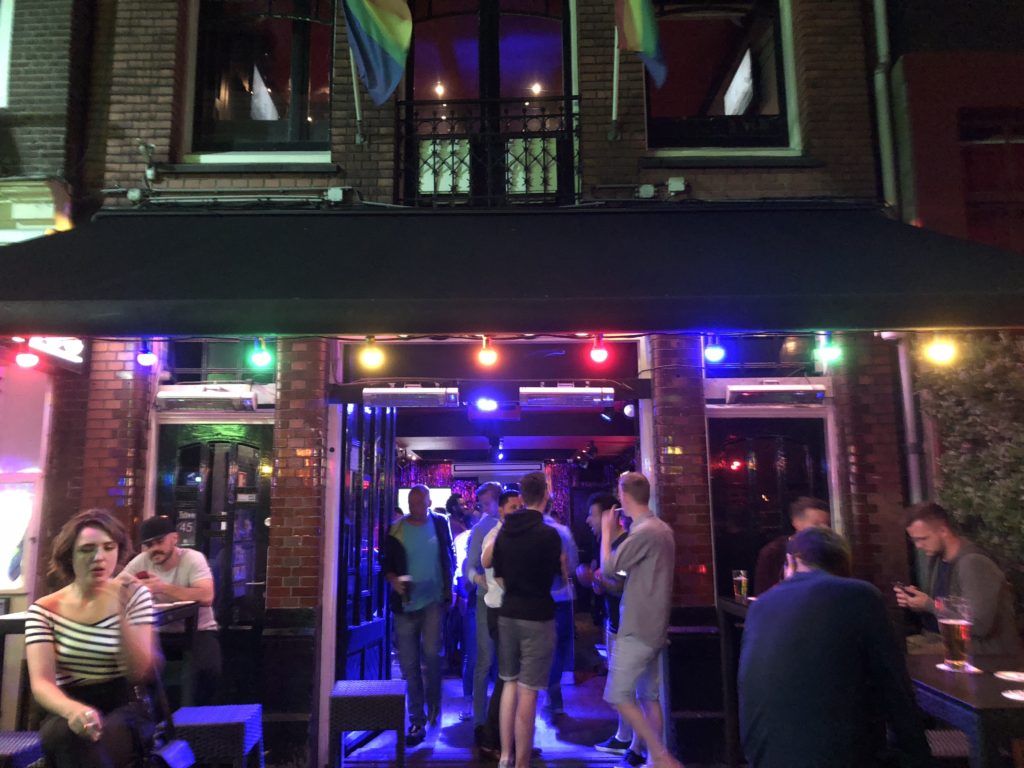
2018.7.3 Day 3: Scavenger hunt in Amsterdam, Dutch Traditional Food, Vondelpark
I woke up this morning at 6 to sporadic shouts from a drunk Dutch man outside. After shower, I went downstairs to eat breakfast in the hostel.
In front of me sat a disabled old man in a dark red shirt. He had to walk around very slowly with crutches. After he sat down, he just lowered his head and stayed there motionless. Later his wife came. She was very tall and slim. Her silver short hair with a blunt bang and triangular black-rimmed glasses reminded of Anna Wintour, the editor-in-chief of Vogue. But she was very simply dressed — white t-shirt with a black long cardigan and black pants. She gently put a hand on her husband’s shoulder, greeted him and asked him in a soft voice if he felt ok. She soon brought back a plate of food for her husband, and then another for herself. Contrary to her husband, she walked very quickly in small steps. She seemed to be walking with her fastest speed for her body leant forward as if about to fall facedown. After the wife sat down and took out a city map of Amsterdam, they went on discussing their travel plans for the day.
I was so touched by their love and passion of living and traveling together. It is easy to stay lazy, to find excuses for not standing up, even with crutches, after being broken by the misfortunes of life. But it is the brave ones, the strong ones, the wise ones who know how to still enjoy everything in life and make themselves happy, even at the dusk of their lives.
We had an very interesting lecture in the morning. The lecturer introduced to us characteristics of Dutch people and examined the permissiveness of the Dutch society in general. After that, a friend and I walked all the way from the library at Roelof Hartplein to a Dutch restaurant around Leidseplein. The restaurant was called The Pantry. With suggestions from the woman in charge, we ordered the two most popular Dutch traditional dishes: Hutspot and Combination of huspot, boerenkool- and zuurkoolstamppot served with smoked sausage. They all resembled smashed potatoes with different sorts of vegetables or meats mixed inside. I mostly didn’t know what I was eating, but I enjoyed the food very much.
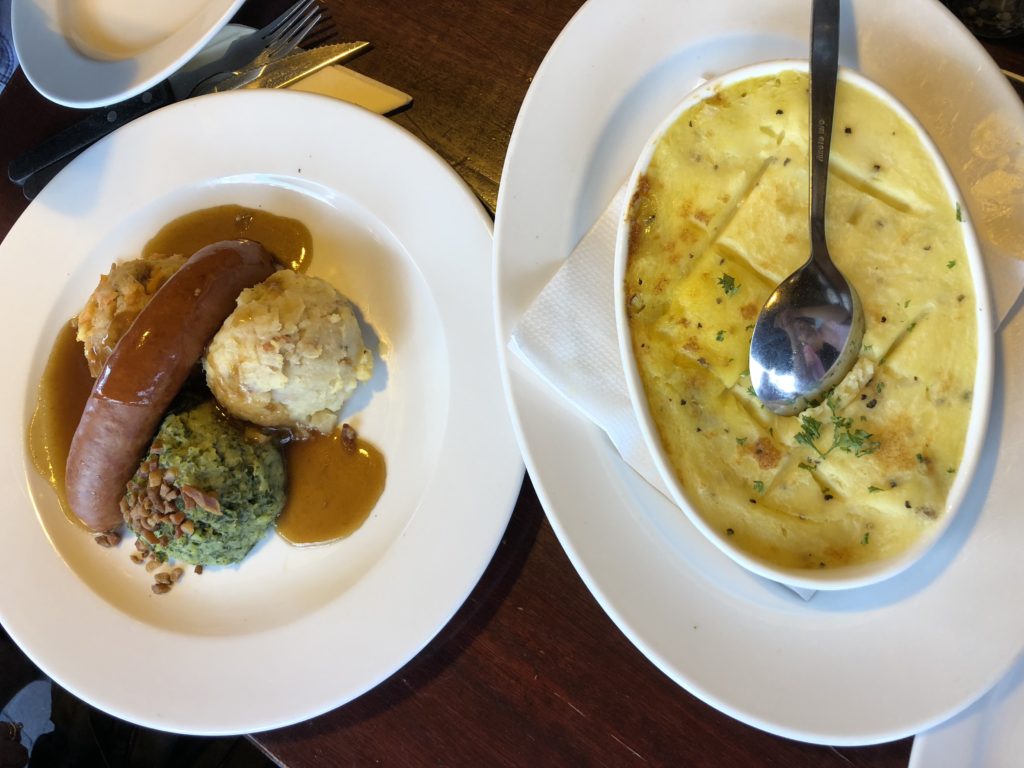
There was almost no space between our table and the ones on my left. All of our conversation must have been heard by the middle-aged American and German couples sitting nearby. But we didn’t care and went on talking about our own relationships and views on different kinds of people. The breeze brought in the sunlight and gave us the courage to pour out all our thoughts to the open ears of strangers.
Our afternoon activity started with a team building game. I was luckily assigned to a team of three with a girl and a guy. For the game we had to use spaghetti and mushrooms to build the highest structure among all teams. We won.
After that, we went on a scavenger hunt trip around Centrum, the City Center district. We walked around very casually, chatting and taking pictures. The streets were crowded but not rowdy. In fact, everyone was either chatting with friends or sitting somewhere with a contemplative look. Everyone was enjoying a piece of the peaceful afternoon under the cobalt blue sky and sharing their pleasure with others.
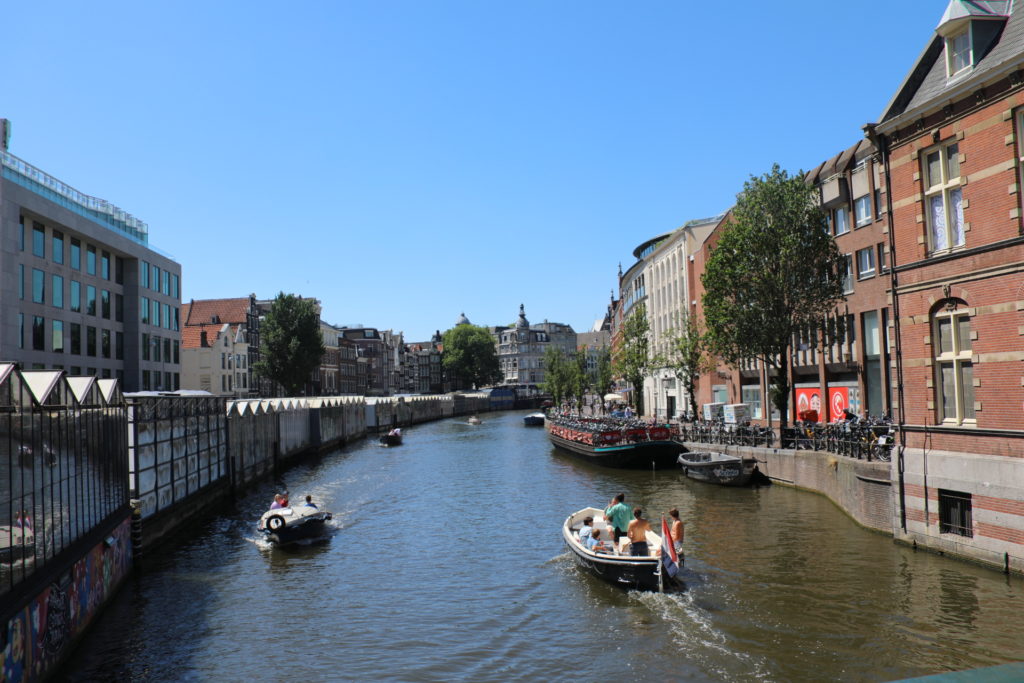
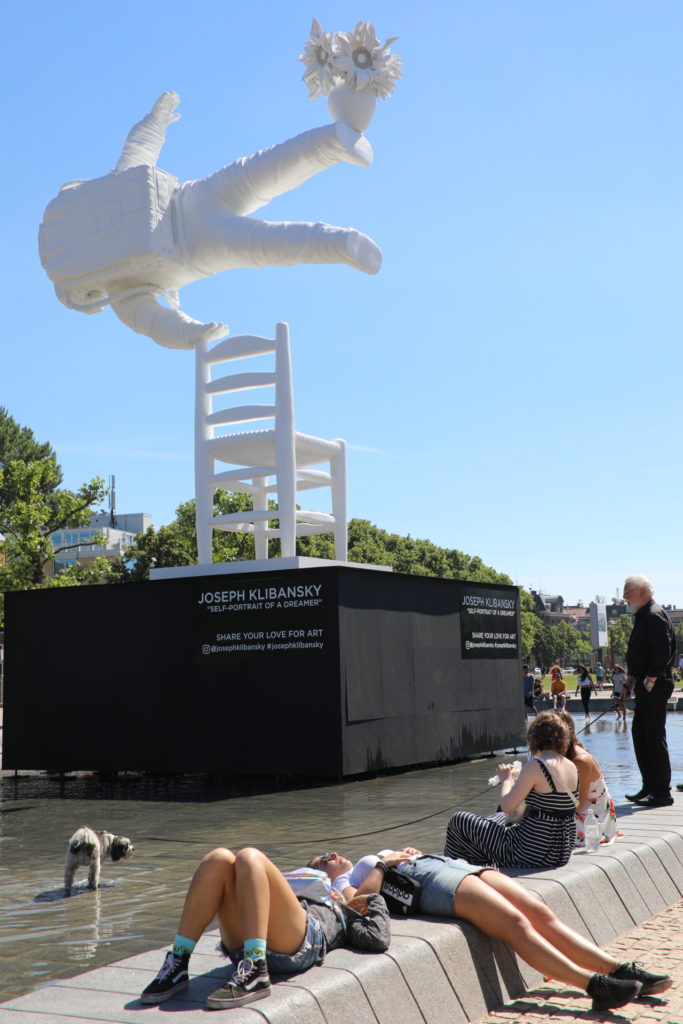
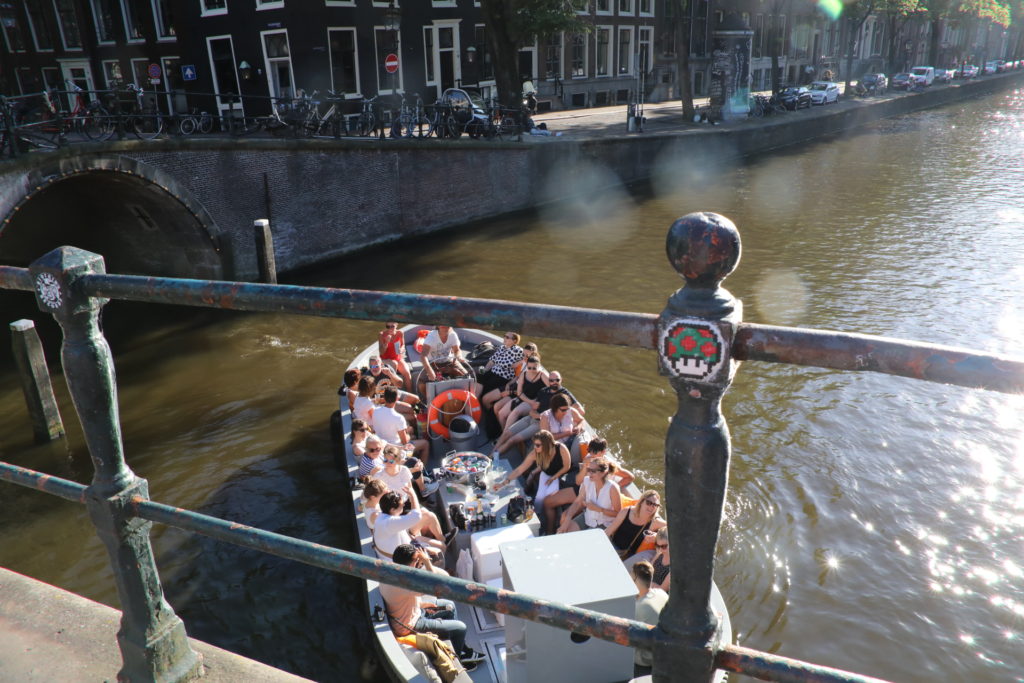
My favorite moment happened on the aisle of the Rijksmuseum. A group of musicians were performing against the wall, surrounded by a crowd. Some of them were playing violins, one of them a black accordion, while some a very strange-looking triangular stringed instrument called Balalaika. I don’t often listen to classical music. Yet the music touched all three of us so much, that at one point we simply forgot about the scavenger hunt and stood there still for a very long time. The melodies reverberated among the arcades under the tall vault, bringing back a piece of the past from the late romantic period.
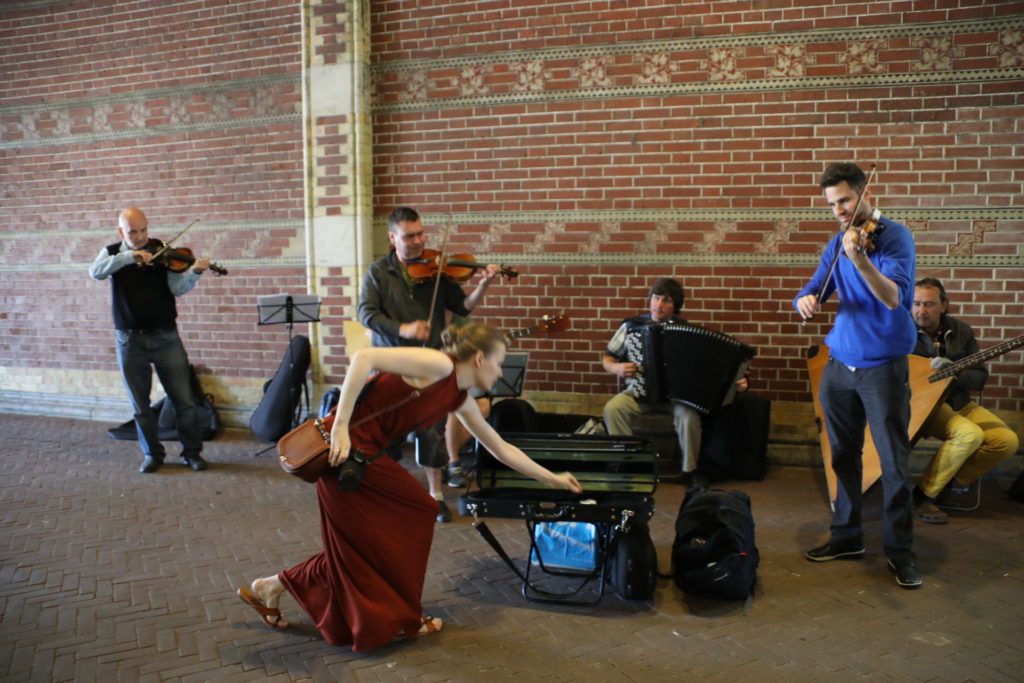
After going back to the hostel at around 4, we sat around the bar and drunk Belgium beer or juices. The directors were also there, chatting casually and taking selfies. The lecturer doesn’t look a bit like a UC Berkeley professor. Here at her own country, her homeland, she is simply an ordinary woman with a warm heart and smile.
After dinner, my friend and I went for a walk in the Vondelpark. The park turned out to be much bigger than I thought, comparable to the size of the Central Park in Manhattan.
People merged perfectly together inside the park, regardless of their races, professions, age or gender. Under the same golden sunlight, the Muslim women with their black hijabs were watching and clapping for the hot Spanish girls with short red dresses dancing wildly to a guitar. A group of young hippy-looking white girls sat next to an old black man playing guitar, singing along loudly with him and waving their arms excitedly in the air. Over yonder sat a couple under a big tree, facing the lake and leaning on each other. The sunlight filtered through the leaves and sprinkled on their fused bodies. They seemed to be enjoying the peaceful and romantic air, far away but still connected to the liveliness of the crowd behind. Everyone, no, every creature here is equal on the same ground, happy and relaxed.

As we were walking on the grass, the girl friend of mine looked around at the couples and told me that she couldn’t help imaging things she could do here with her boyfriend. This girl is in love! How sweet!
2018.7.4 Day 4: Train from Amsterdam Central to Utrecht, Utrecht University, Dom Church, Dinner by canals
Happy Fourth of July!
I woke up early at 6 again. I went down by myself to eat breakfast and write journals. The old man again slowly walked past by me. The same routine, the same spot for him and his wife.
Today we travelled from Amsterdam to Utrecht.
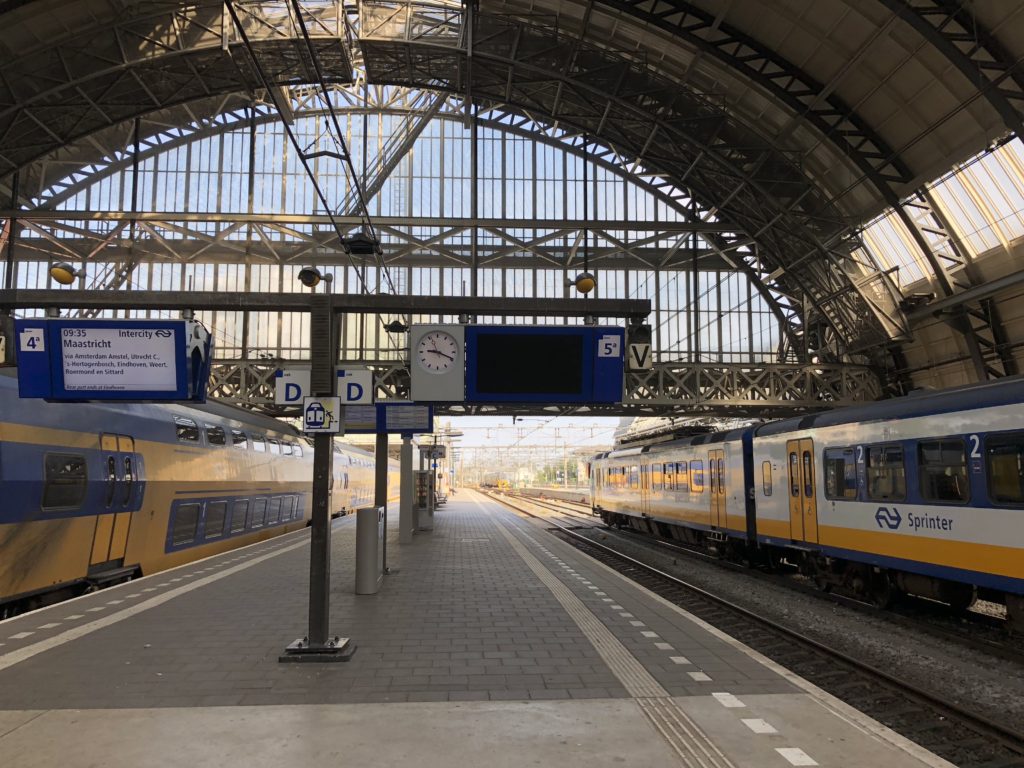
We took the tram to the Centraal station at around 9. The Centraal station, with its Neo-Gothic style façade and turrets, was surrounded by the white and blue modern-looking trams travelling swiftly on the rails. The mix of elements from the past and the present gives rise to an illusionary sense of anachronism. The station, designed by Pierre Cuypers, reflects the romantic and nationalistic mood of the late 19th century Netherlands, glorifying the nation’s colonial power with the big decorative facade.
It took about half an hour to go from Amsterdam to Utrecht by train, which was very quiet and neat. We walked to the Utrecht University (UU), where two professors and a UU student introduced the Netherlands image and the Dutch student life to us.
A history professor in UU gave us a lecture about the Netherlands in American eyes. According to him, the international constructions of the Netherlands image have two sides.
On the one hand, the utopian image is cheerfully associated with windmills, tulips, wooden shoes and green polders. People ride their bikes along the beautiful canals in the city. Lovers and friends always hang out under the picturesque sunset scene. People speak their minds freely, rejects authority and dogma, believe in an egalitarian society, and tolerate different views.
But on the other hand, the image of open-mindedness and tolerance is also being turned into a dystopian image of permissiveness and moral bankruptcy. The foreign media constantly associates the Netherlands with drugs, prostitution, euthanasia, abortion, child pornography, and other controversial ethnical issues. The term “Dutch disease” was coined to criticize the over-generous welfare state for the unemployed citizens and recent immigrants.
The term “Hollanditis” was also termed to describe the wave of pacifist neutralism that swept through the country in the early 1980s.
It was very interesting to me how the image of Netherlands in the eyes of Americans has changed throughout the eras. From the anti-Dutch sentiments in the 17th and 18th century to the Holland Mania in the 19th century, the Dutch did not seem to change that much. It was the media that truly had the power to invent and implant images in people’s minds— now you see how vulnerable and fickle are the knowledge and truth that we think we know?
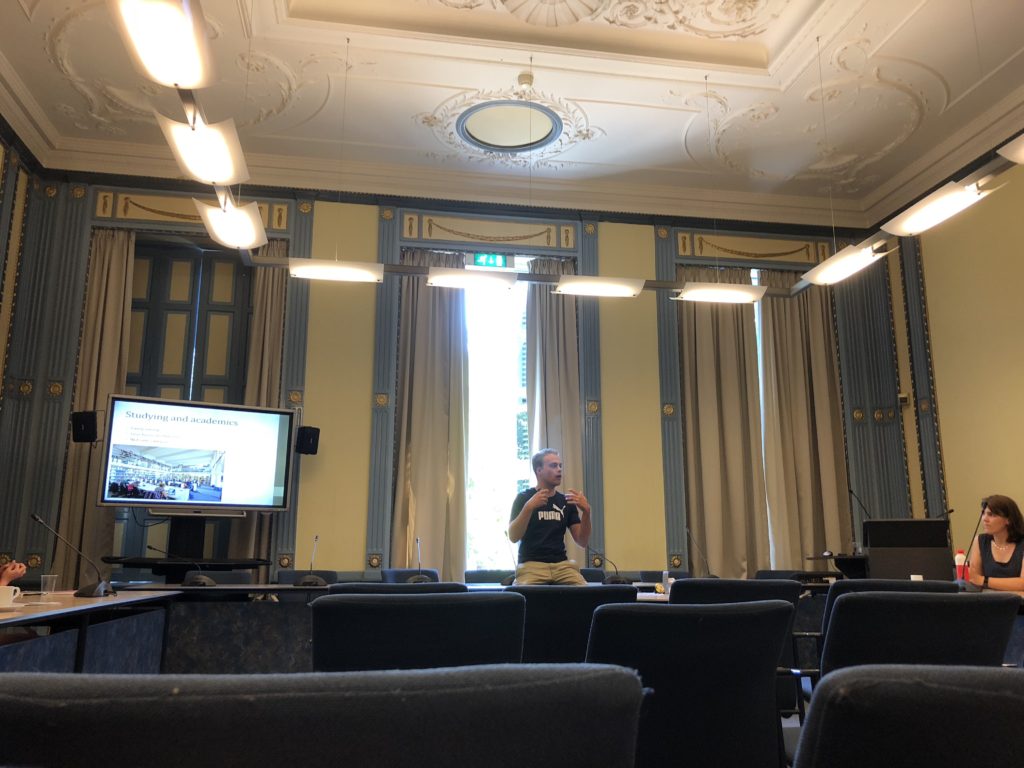
After the lecture, a UU student, who exchanged to Berkeley for half a year, told us about the main differences between student life in the Netherlands and in the States. First, Dutch people do not share rooms. All the dorm rooms are single. But at dinnertime, all the student residents will make and have dinner together in the common living room — again, the idea of togetherness. Second, the Dutch universities also don’t have their own sport teams. There’re only sports societies, such as those of rowing, rugby, hockey, or football (soccer). Moreover, Daan said he was very disappointed at the party scenes at Berkeley. According to him, parties and festivals are big deals in the Netherlands, with countless bars and clubs of techno, LGBT+, hiphop etc. Since the drinking age here is 18+ and there are hundreds of coffeeshops in every big city, the foreigners often develop a stereotypical image of Dutch students celebrating 4/20 everyday.
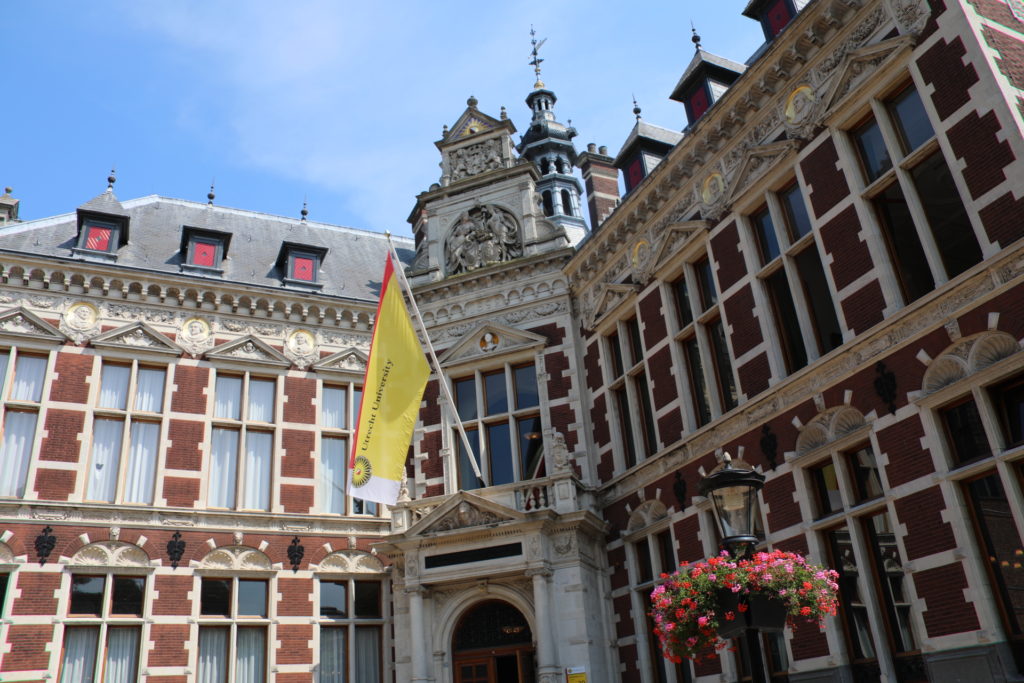
After the university program, we went on to a guided city tour. The tour was almost two hours, so I will just jot down some highlights for me during the tour.
Our first stop is the University Library, which has a legendarily amusing history. After Napoleon Bonaparte came to power in 1802, he appointed his brother Louis Bonaparte as king of Holland in 1806. As Louis didn’t enjoy The Hague, he moved the capital to Utrecht in 1807 and lived in the palace now used as the University Library. As for his wife Hortense — she did not want to wave goodbye to her homeland France at all. According to Ingeborg, she and her husband, the king, hated each other! They even build a wall in between the palace so as to not see each other’s faces. “See what marriage does.” Ingeborg joked with all seriousness.
Since Utrecht has been the religious center of the Netherlands since the 8th century, the Dom Church, a Gothic pre-Reformation cathedral, was originally built for Catholicism in the city. However, after the Protestants took over the Netherlands, the Dom Church and all other churches have been Protestant since 1580. Following the Reformation, the Catholic Church was legally obliged to worship discreetly in clandestine churches.
After the city tour, we were given free time to take a walk around the city, known for churches, museums and the Dutch cartoonist Dick Bruna’s Miffy! After we bought some postcards and super cute Miffy dolls in small shops along the narrow streets, my friend and I slowly walked our way back to the Dom Church.
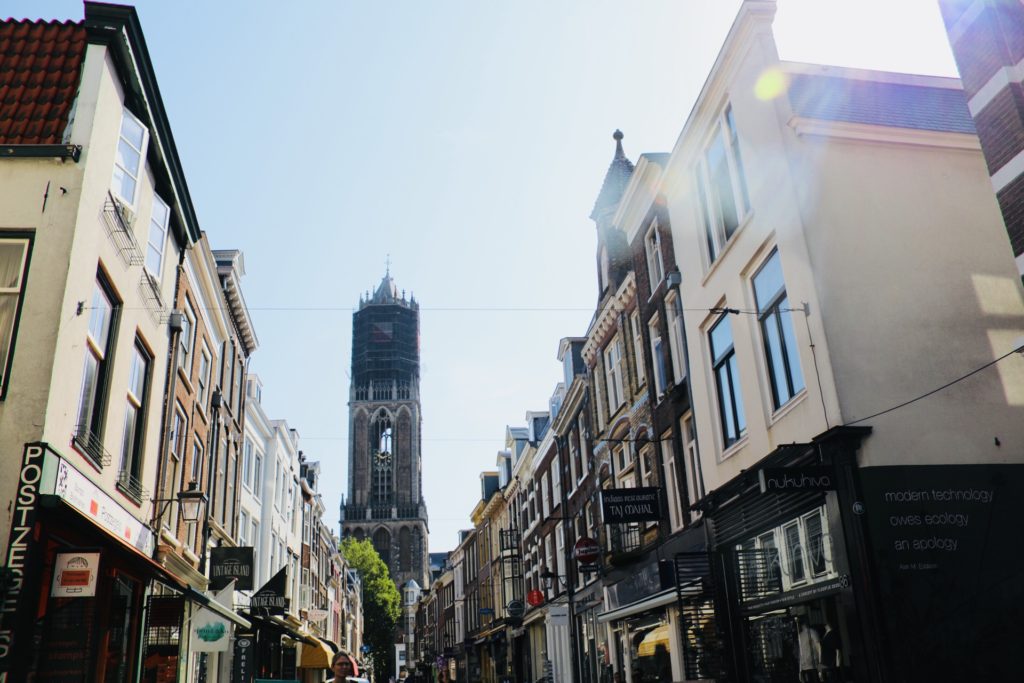
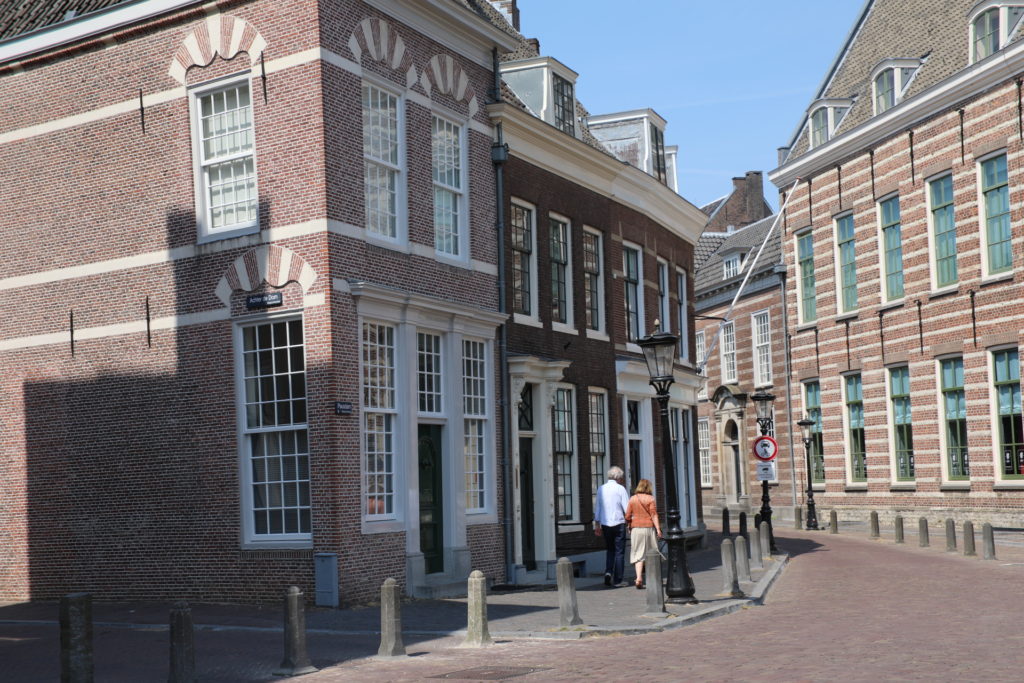
Suddenly, under the statue of a woman raising a torch outside the Dom Church, a man proposed to a woman. The man knelt down with handful of red roses, and put the ring on his fiancee’s finger. Surrounded by only parents and a few friends, they hugged tightly and kissed each other. Then the girl turned around to hug her mom and dad, who was gently stroking their daughter’s hair. They whispered sweetly and happily into each other’s ears, as if sharing the secrets of living a happy life.
Near us, two street musicians were performing with violin and cello. The lively melodies and easy rhythms became the background music and seamlessly merged into the whole scene as if arranged by Mr. McFate. My eyes became wet while I was witnessing this sacred moment as a stranger.
It was simple. But I was struck by the simplicity of the proposal. It is the simplicity that conveys the power and pureness of human love. It is an modest and unadulterated love — without any affected rituals, without any gaudy displays, without any pretentious postures. It needs nothing extra in order to appear consecrated or glorified, because it is already the most sacred thing in nature. I wish them the happiest marriage and the most sustaining love!
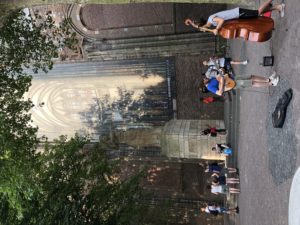
At 6, we walked down to a restaurant right by the main canal. It was called the Broadway American Steakhouse. The restaurants sitting on the two sides of the canal were completely filled with people from all parts of the world. One can’t help but eavesdropping others’ conversations there, since all the tables are squeezed together on a narrow path. On the canal were open boats with a small table full of alcoholic drinks on top. People on the boats were either sitting with a glass in their hands and enjoying the breeze passing by, or sleeping in the most carefree posture with arms and legs spread wide open.
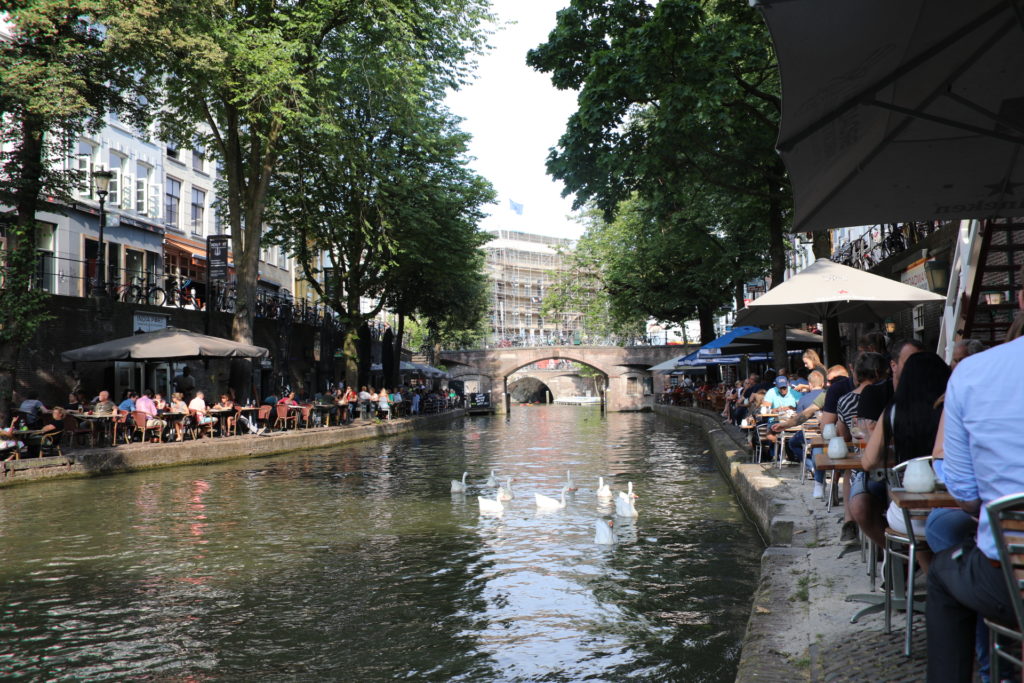
The stillness of calm waves gently drifted by. But the white geese were always gaggling by our side, breaking the calmness of water and aggressively demanding food from the eaters.
We took the train back at around 8 and took the tram back to the Stayokay Hostel.
After I stayed in my room and wrote for two hours, I went down for a cigarette break and some inspirations. It was around 11. A lot of young smokers, both of cigarettes and of cannabis, sat on the stairs outside of the hostel in the dark. A group of students in our program went to hit bars for the celebration of the Fourth of July. But I was too tired and was ready to officially end the long day by myself.
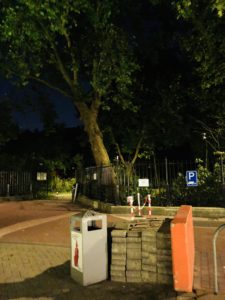
2018.7.5 Day 5: Rijksmuseum
The lecture this morning was about the art, culture and society in the 17th century Dutch Republic. The paintings of the 17th Dutch Republic were unique because they reflects the Republic as burgerstaat (citizen-state). In other European places at that time, art was a luxurious product not quite accessible to the ordinary citizens. Paintings were made for church, nobility and royal courts. However, in the Dutch Republic, the political and economic power was not with nobility or clergy, but with elites of the bourgeoisie: merchants, politicians, scientists. Everyone, including the poor people, possessed paintings. In fact, 5 million paintings were produced in the Netherlands in the 17th century!
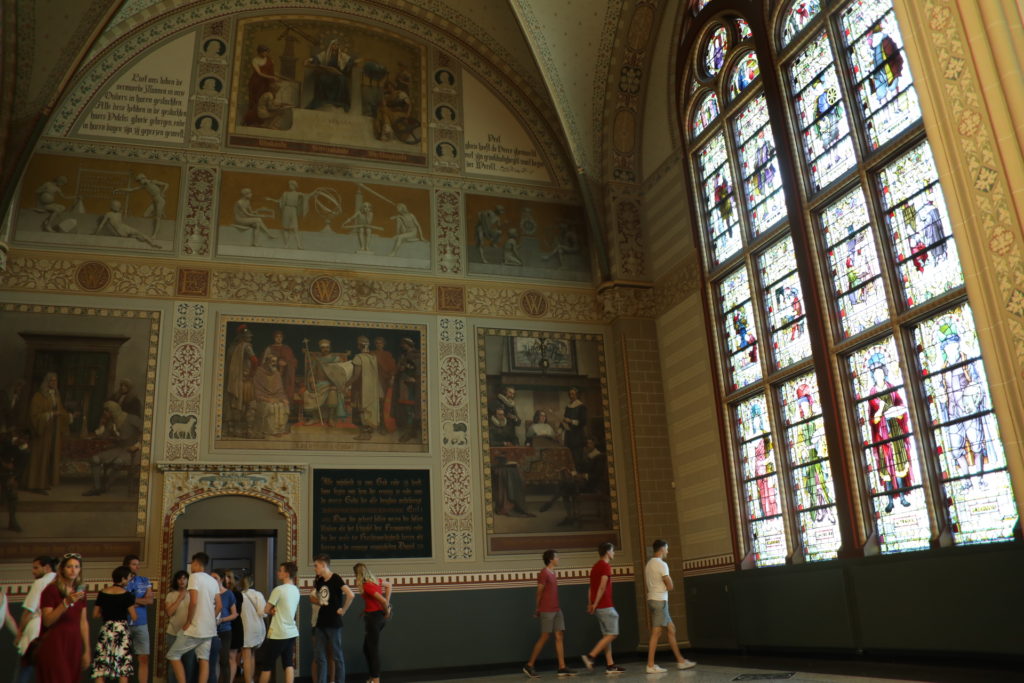
In the afternoon, we went to the Rijksmuseum to see the 17th century masterpieces by Rembrandt, Frans Hals, Johannes Vermeer and many others. But first, I want to introduce a bit about the four types of paintings produced at that time: genre painting, portrait, landscape and still life.
Genre painting depicts domestic scenes, street scenes, ordinary people and their daily activities. The paintings usually convey a moralizing message. A good example is Jan Steen’s “The Merry Family” (1668). The boisterous family is having a great deal of fun. The father sings while raising his glass. The mother and grandmother chime in. The children are blowing into a wind instrument or smoking a long pipe. The note hanging from the mantelpiece gives away the moral of the story: ‘As the old sing, so shall the young twitter.’ If the parents set the wrong examples, what will become of the children?
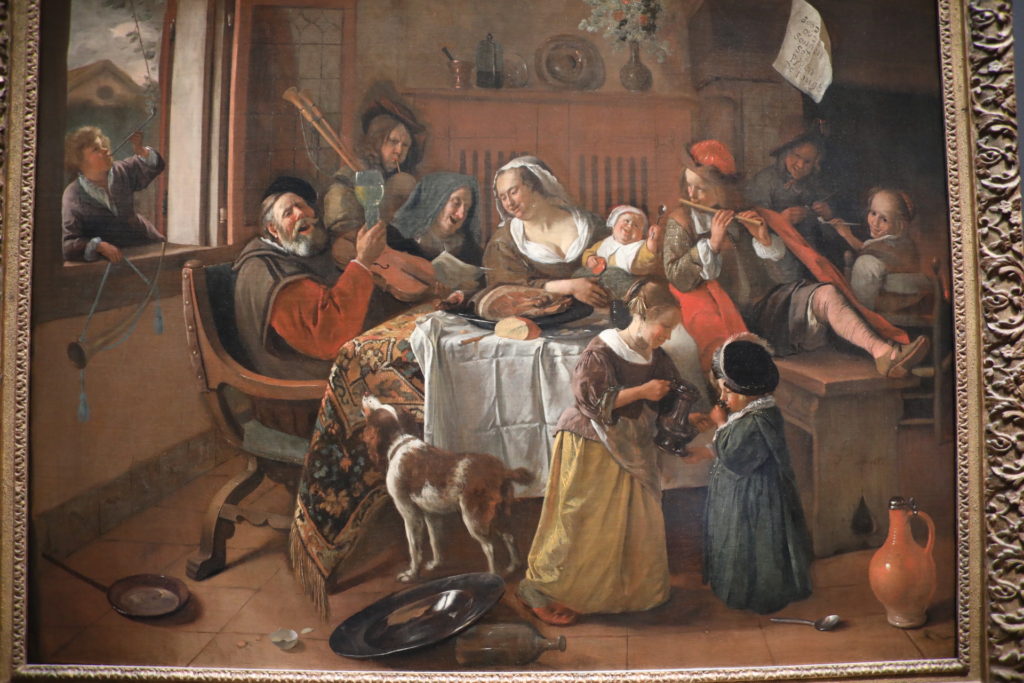
Portrait paintings were very popular among the rich people. One example is Rembrandt’s “The Night Watch” (1642), which depicts a group of Amsterdam’s civic guard, a militia company that protected the city. Rembrandt is the first artist to paint a group portrait with the figures in action and with the dramatic use of light and shadow (tenebrism). The mysterious woman in the background carries a chicken with pronounced claws and a pistol called a klover, which were symbols of the Kloveniers, the civil guard. It is Rembrandt’s most famous painting, arguably the greatest portrait of the 17th century Dutch.
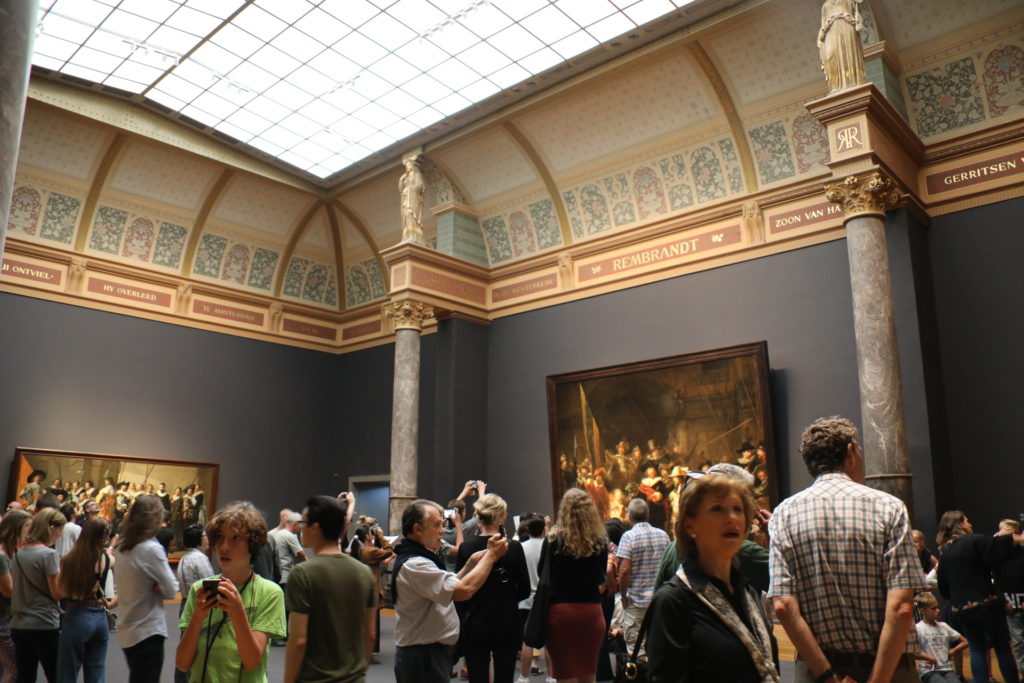

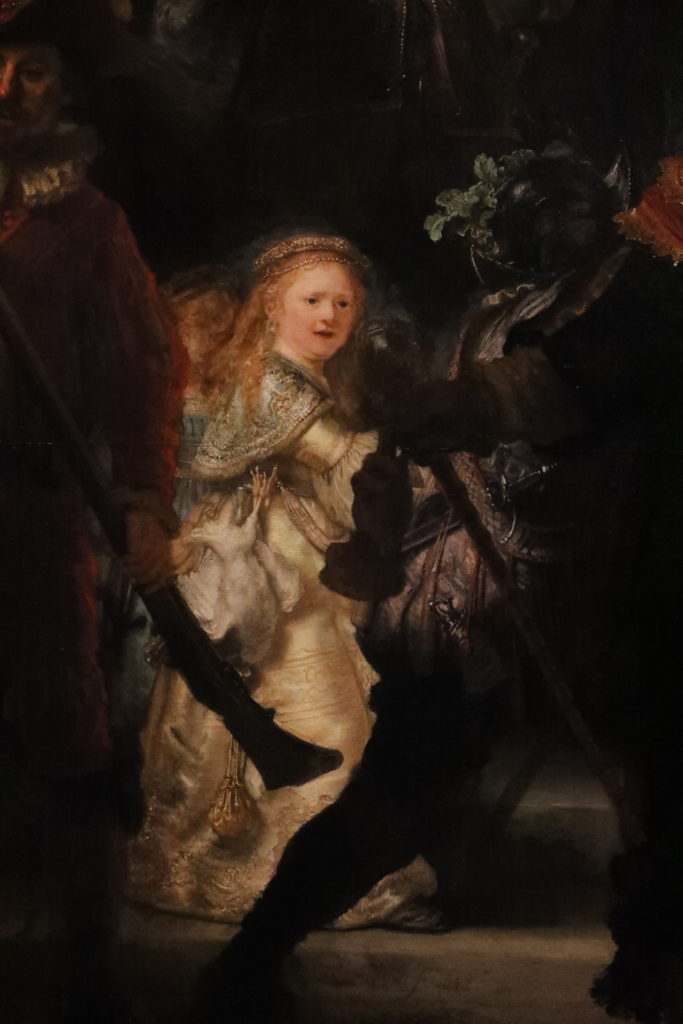
Landscape paintings were the most popular among the ordinary people. The typical flat Dutch landscape has a low, straight horizon extending under a vast sky with billowing cumulus clouds. This feature is illustrated perfectly by Ruisdael’s depiction of the view of Haarlem. Another famous winter landscape painter is Hendrik Avercamp. Deaf and mute, he painted “Winter Landscape with Skaters” (1608) in a colorful and lively way. But the painting is also narrative with many anecdotes and mischievous details included. For example, if you look closely, in this painting there hides a couple making love, bare buttocks and a peeing male.
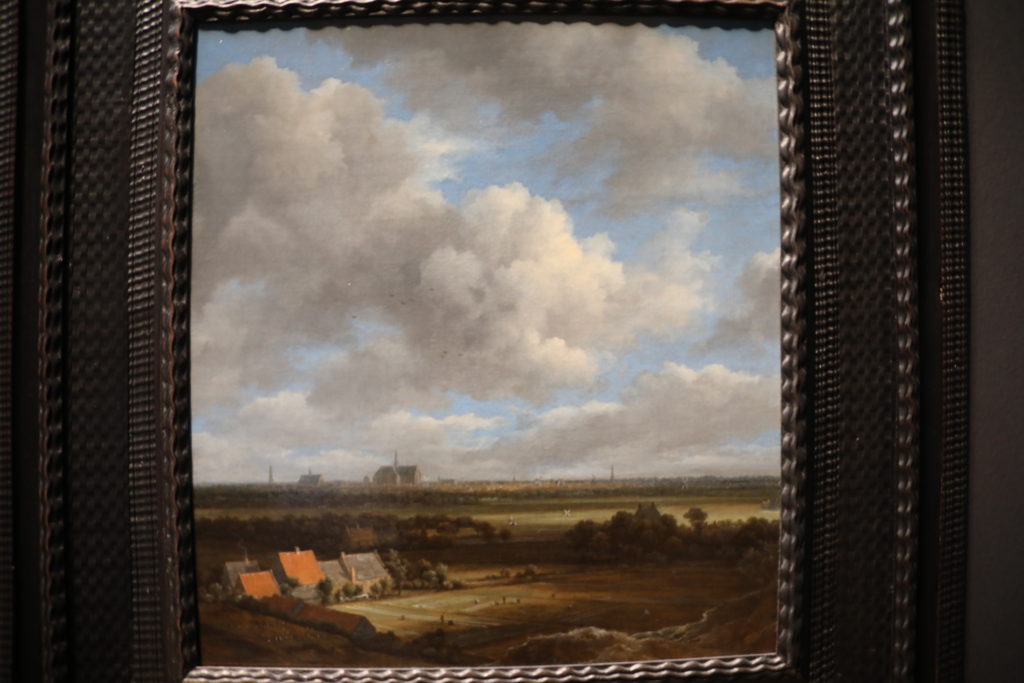

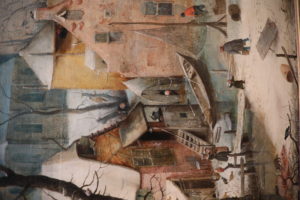
Last but not least, still life paintings display to the greatest extent the extraordinary painting skills of the maters. A popular type is the vanitas still life paintings, such as Pieter Claesz’s “Vanitas Still Life with the Spinario.” With a timepiece, bones and a skull, musical instruments, the message is clear: everything is mere illusion and transience (vanitas). Indeed, all life comes to an end.
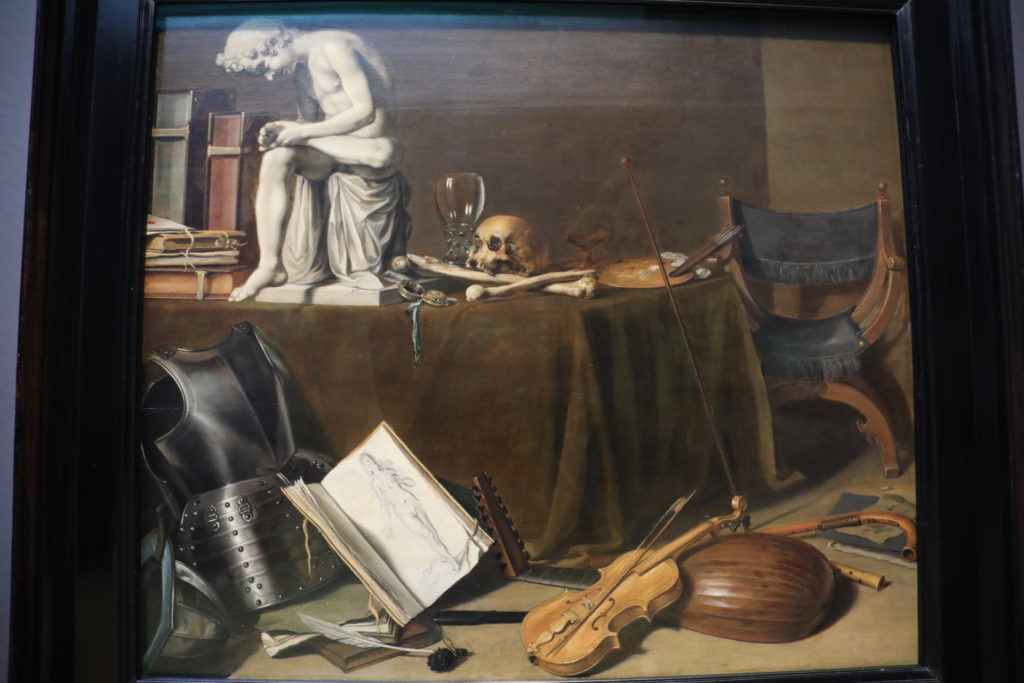
Among all the paintings I’ve seen today, two touched my heart the most.
One of them is Rembrandt’s “The Jewish Bride” (1665-1669). Van Gogh, after seeing this painting at the opening of the Rijksmuseum in 1885, said in a letter that he would have given ten years of his life just to sit in front of the painting for two weeks.
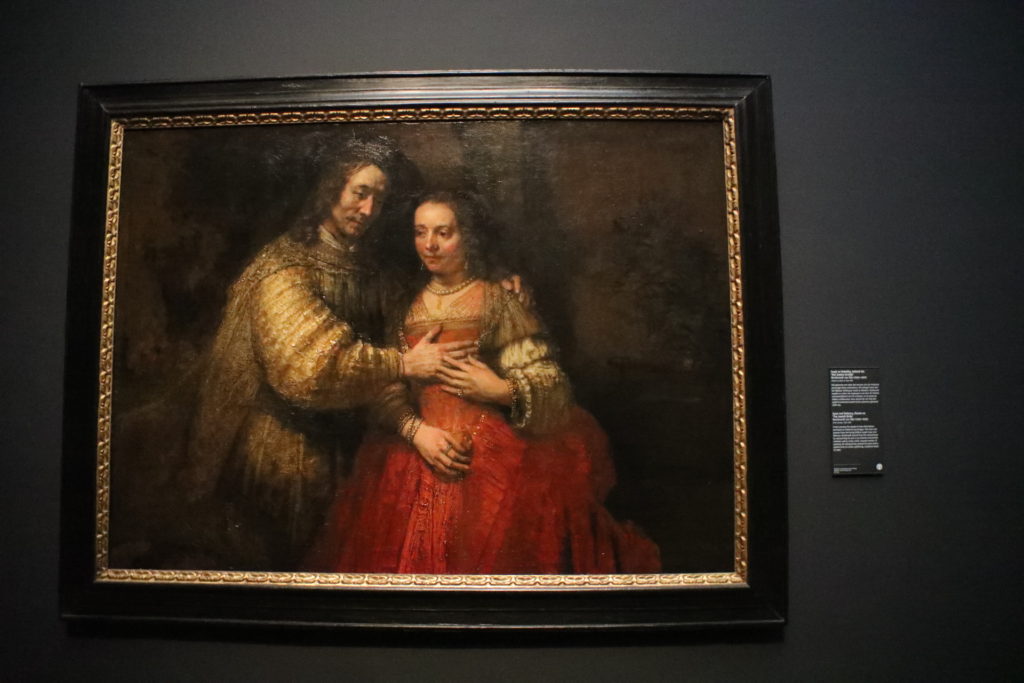
In this painting, we see a man touching a woman lovingly. They are depicted as the loving biblical couple Isaac and Rebecca. Rembrandt freed himself from all convention in this painting. He represented the pair in an intimate and private moment under within a dark ambiance. He used a thick, impasto manner of painting, simply scratched in the paint with his brush handle and smeared it with a palette knife like a rough and mischievous child.
In the biblical story, the married couple Isaac and Rebecca run away to a foreign country to escape the soldiers and to preserve their love secretly. For the exotic clothing, Rembrandt applied thick daubs of paint to render Isaac’s golden sleeve and used the palette knife for Rebecca’s red dress to create a glittering, sculptural sense of relief.
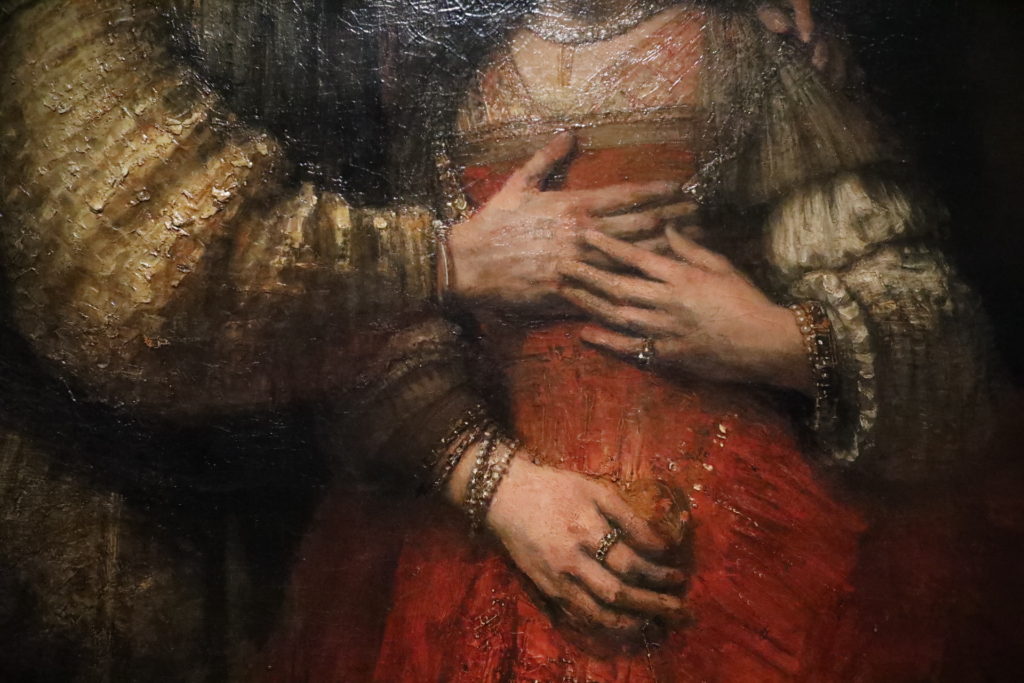
It is true that the painting appears coarse or even messy if you look closely. But to me, this is what love means for humans: it should be a passionate and spontaneous revelation, with no polishing or modification. There is no need for precision or perfection, for human emotions is neither precise nor perfect. Coarseness embodies pureness. The unrestrained thick brushstrokes represent a powerful outpouring of genuine emotions.
The other one is “Portrait of a Couple” by Frans Hals (1622). In a garden, a man sits in the left foreground, tilting his head and smiling casually at the spectator. Beside him sits a woman, whose right hand naturally resting on the man’s left shoulder. She turns her head slightly to the right and smiles rather slyly, They both look happy and smiling, sitting comfortably close to each other. In fact, posing a couple together in such a casual and intimate way was highly unusual during the 17th century. But it is exactly the lack of formality that makes us, the modern spectators, traverse through time — and become personally touched by a sacred moment of love and commitment from four hundred years ago.
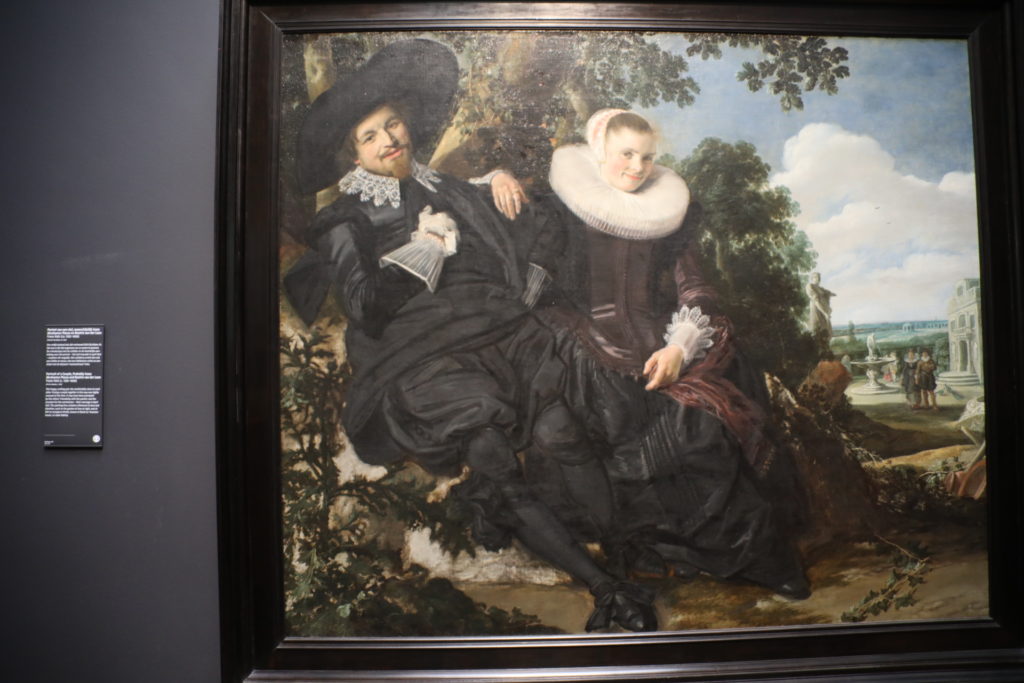
The occasion for the commission is the couple’s marriage in April 1622. The imaginary garden on the right contains young couples strolling, a white sculpture of Juno, the goddess of marriage, as well as a fountain, a symbol of fertility. On the left, the eryngium thistle is known in Dutch as ‘mannentrouw,’ or male fidelity. The ivy at the woman’s feet is an evergreen that binds itself to the place it grows, symbolizing eternal love and devotion.
The masterpieces kept me spellbound until the guards started kicking people out at 4:55. As I left the museum, I felt as if my heart has been both weighed down by the heavy history lost to the past and, at the same time, lifted up by the dreamy and lively narration style of the paintings, through which the masters present to us countless fragments of history, from most splendid to the most trivial.
2018.7.6 Day 6: Train to Delft, Hall of Prinsenhof, Old & New Churches, Local nightclub
Hoihoi!
In the morning, the Dutch lecturer gave us a brief Dutch language workshop. Then we took the train to Delft at noon. It is definitely one of the most beautiful places I’ve seen so far in the Netherlands. The city is world renowned for its close ties with the Dutch Royal family and the famous Dutch painter Vermeer, its Delft Blue earthenware and other technological and artistic innovations.
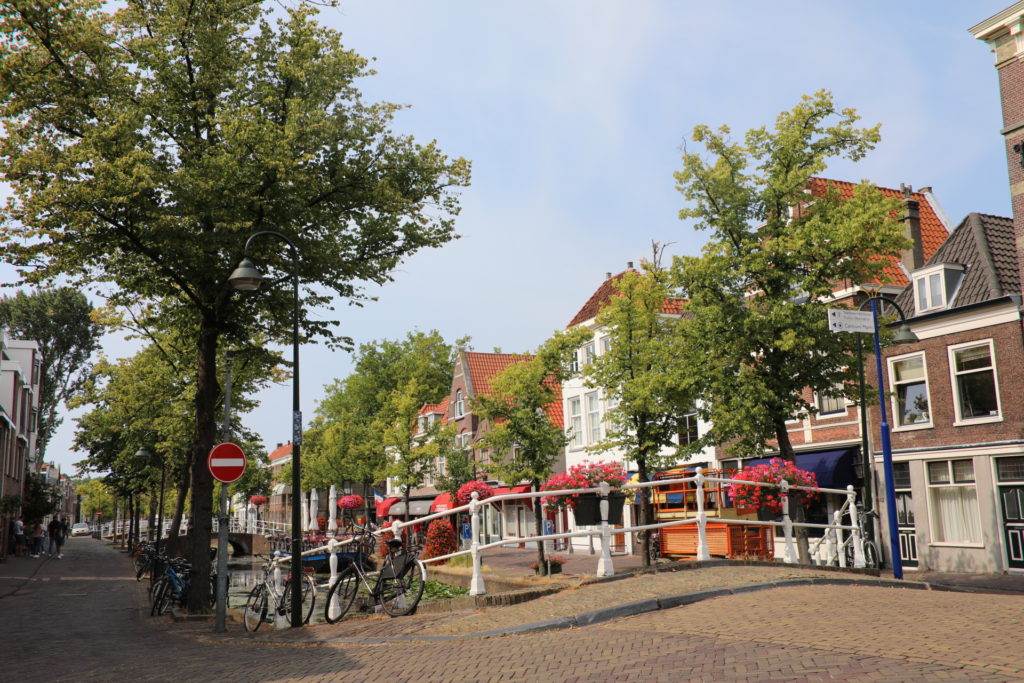

William of Orange, or William the Silent, took up residence at the Prinsenhof in Delft in 1572. He was the leader of the Dutch revolt against the Spanish Habsburgs, known as the Eighty Years’ War. He is also known as the Father of the Fatherland. After the Act of Abjuration in 1581, Delft became the seat of the Prince of Orange, and also the de facto capital of the newly independent Netherlands.
We visited the Hall of Prinsenhof today, where William of Orange was shot dead at a close range by Balthazar Gerards in 1584. He was the first head of state ever to be assassinated by a hand gun. In the Prinsenhof we even saw the big bullet holes on one of the walls near the staircase.

The Prinsenhof is also the home to many great paintings from the Golden Age, as well as an impressive collection of royal portraits. The paintings, such as the “Anatomy Lesson of Dr. Willem van der Meer,” clearly show that the Dutch were at the forefront of technological and artistic inventions.
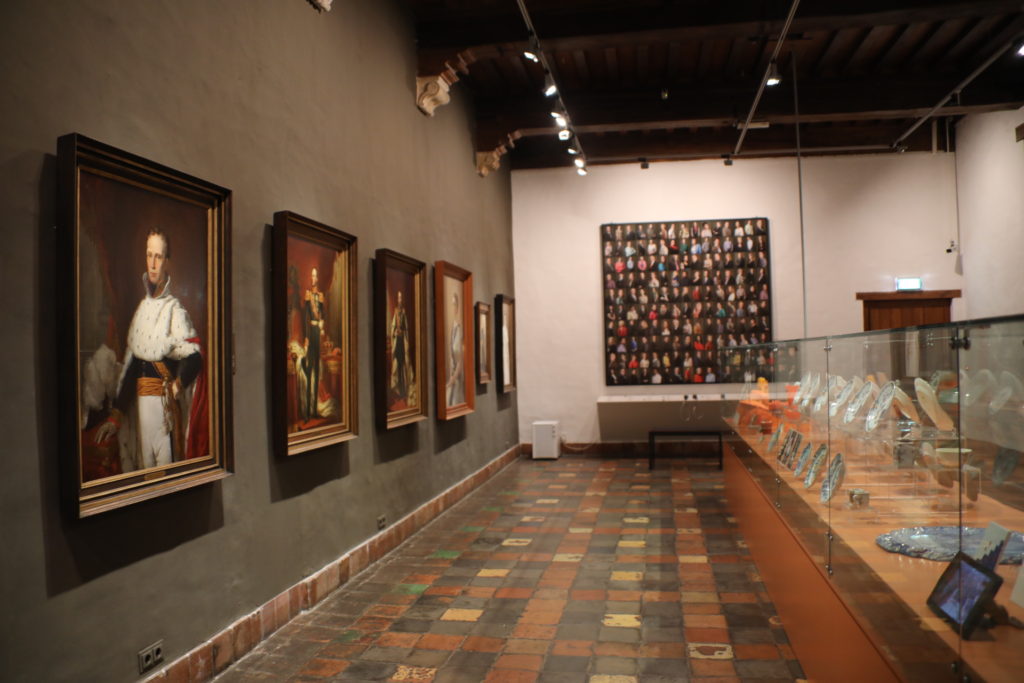
There was also a special exhibition about Art Nouveau and New Objectivity in Delft.
Art Nouveau is an international style of part characterized by natural forms and structures, such as asymmetrical decorations in curved lines based on plants. It flourished between 1890 and 1914. New Objectivity, most popular between 1918 to 1933. It was featured by the pursuit of functional art and architecture — free of outmoded and unnecessary ornamentation. It is closely related to the simplicity and abstraction association with the Dutch art movement De Stijl.
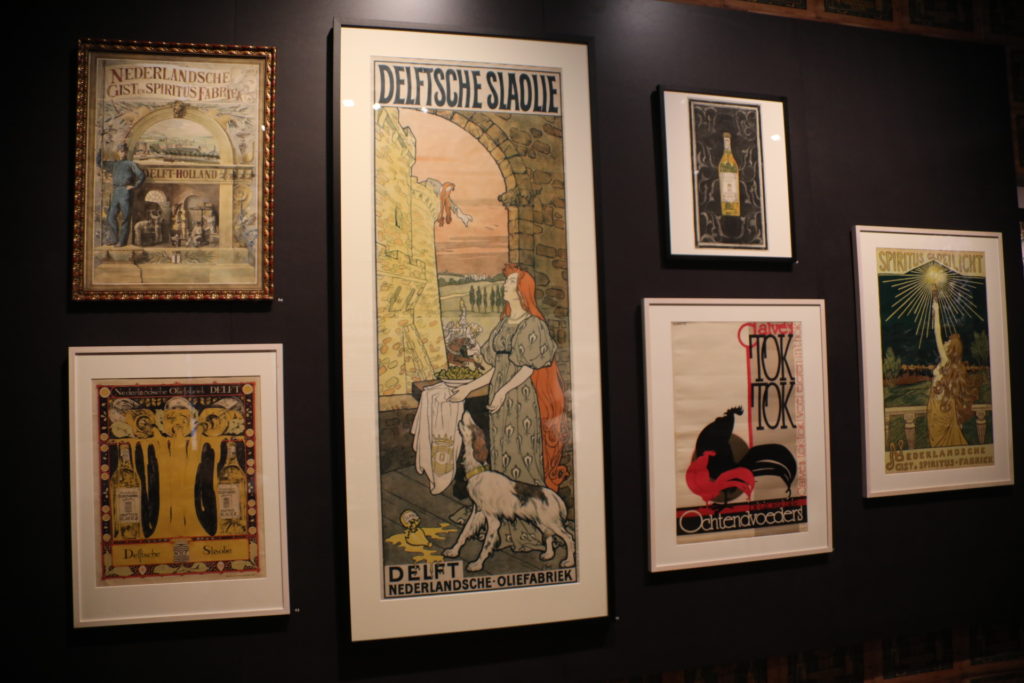
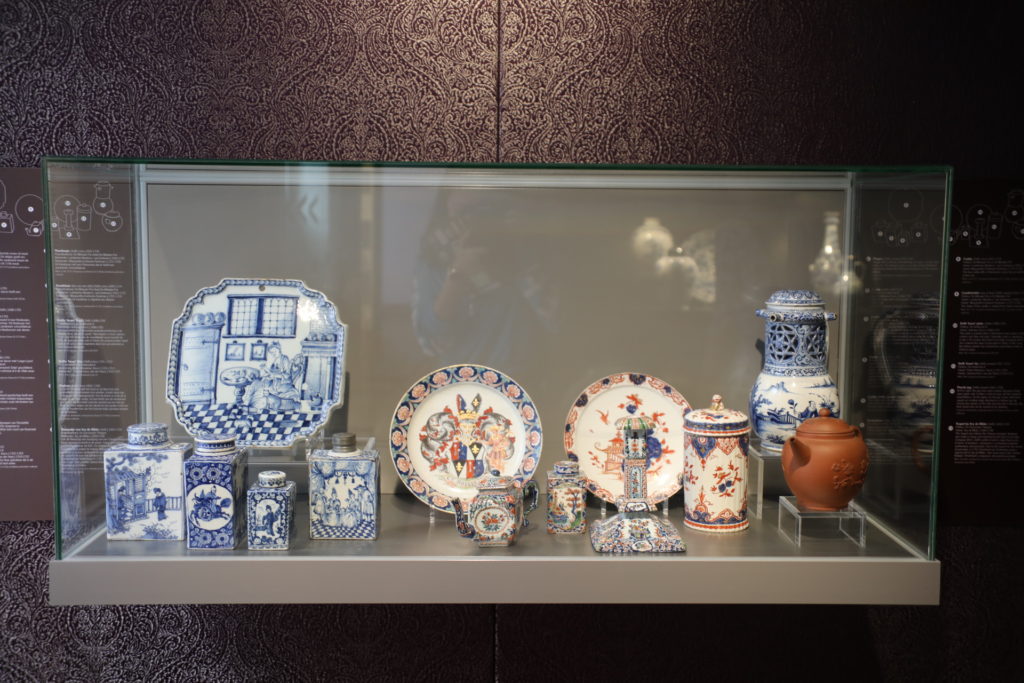
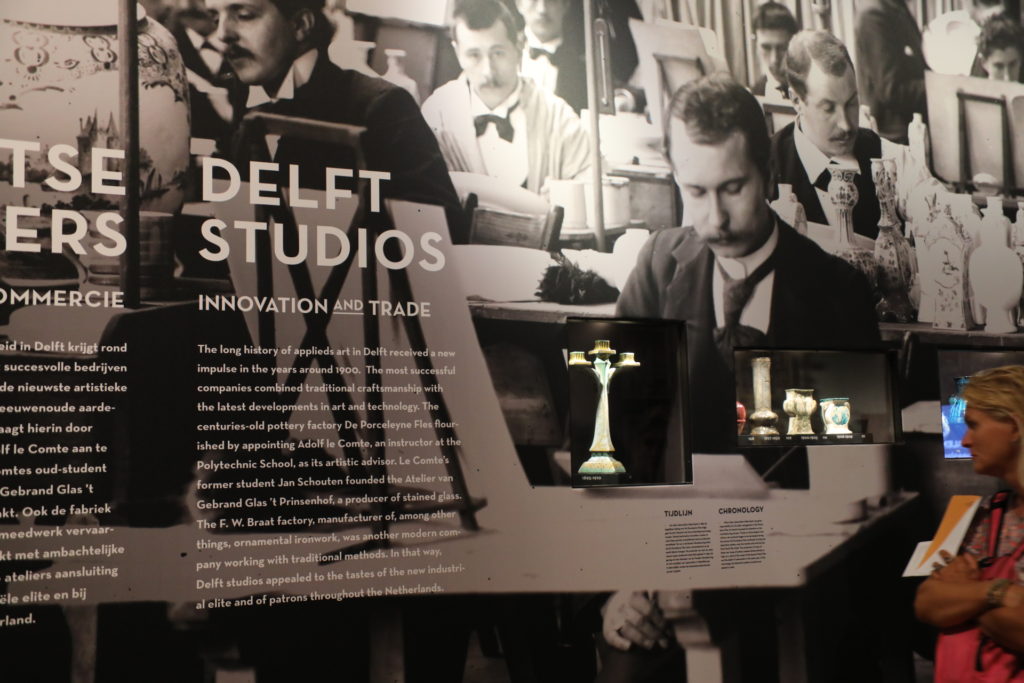
Through the artworks displayed — artistic and commercial posters, Delftwares, stained glass windows and so on, we can see how Delft emerged as the leading city in the Netherlands in terms of art, knowledge and industry. Modern industrial factories and the Polytechnic School were established. The artists took advantages from these developments and created some of the most innovative artworks of their era, between 1880 and 1940.
But what Delft impressed me the most were the churches, the Old Church and the New Church.
The Oude Kerk (Old Church) was founded in 1246 with a central nave flanked by two smaller aisles. Contrary to most church-visiting experiences, the first thing you will notice in the Old Church is the floor. Approximately 400 well-known people were buried in the Old Church, including the famous painter Johannes Vermeer and the scientist Anton van Leeuwenhoek.
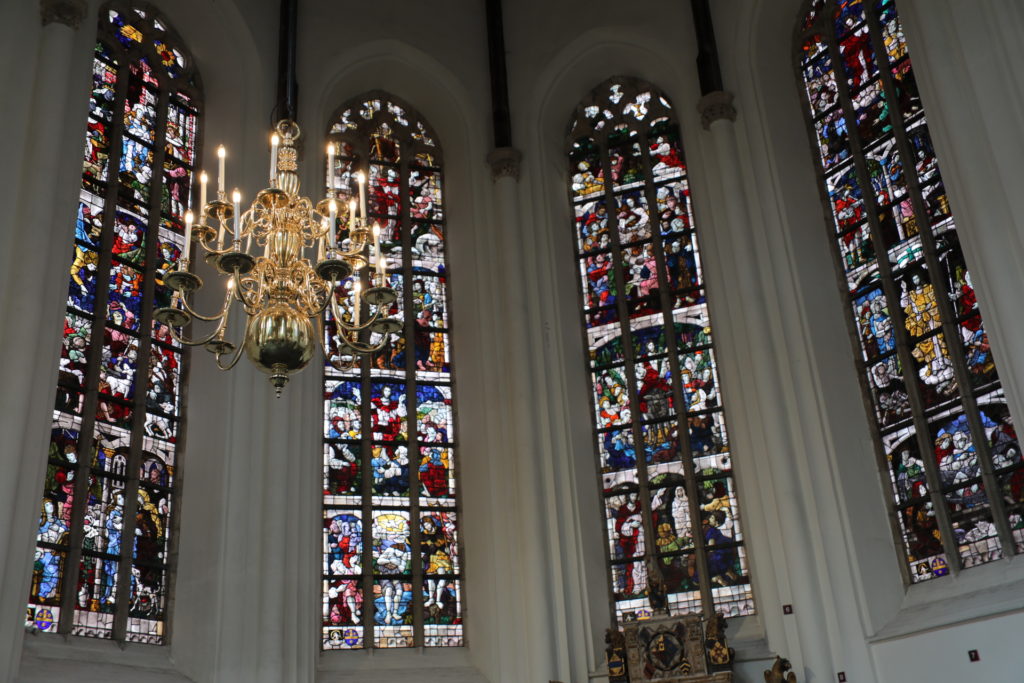
Some dramatic events left their marks on the Old Church. After surviving a city fire in 1536, the iconoclast came and demolished anything considered “Romantic Catholic.” Despite of the great fire, iconoclasm, or the explosion of the town’s gunpowder store in 1654, there remains something about the church that cannot be taken away. Perhaps it is the collective spirit of all the dead buried here that gives rise to a sense of holiness, even for someone agnostic like me.
The Nieuwe Kerk (New Church) became home to the Masusolem of William the Silent in 1584. Since then, all members of the House of Orange-Nassau have been entombed in the royal crypt. The unusual light of those enormous chandeliers fell on the stained glass windows. It gave life and actions to the characters depicted on the artisanal glass windows, which tell the mysterious story of the centuries-old church.
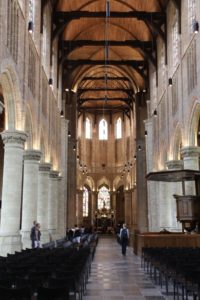
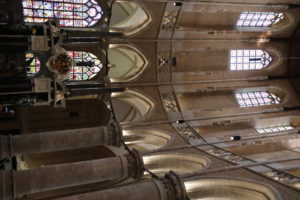
Elaine and I walked to the East Gate of Delft, which looks the same as the West Gate depicted in Vermeer’s “View of Delft.” After that, Yiman joined us in having dinner at Willem van Oranje, a really gezellig (cozy) restaurant in the Market Square. On the left side stands the lofty spired tower against a unusually sunny Dutch sky. The tower faces the decorative façade of the City Hall, which looks like a fairy-tale castle.
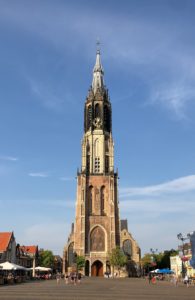
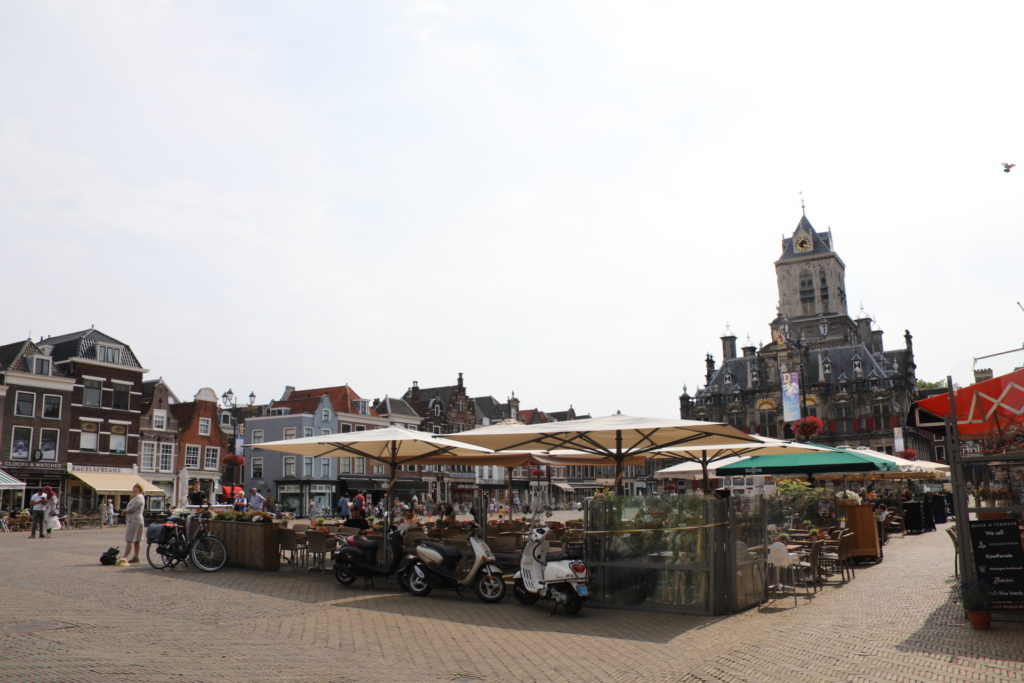
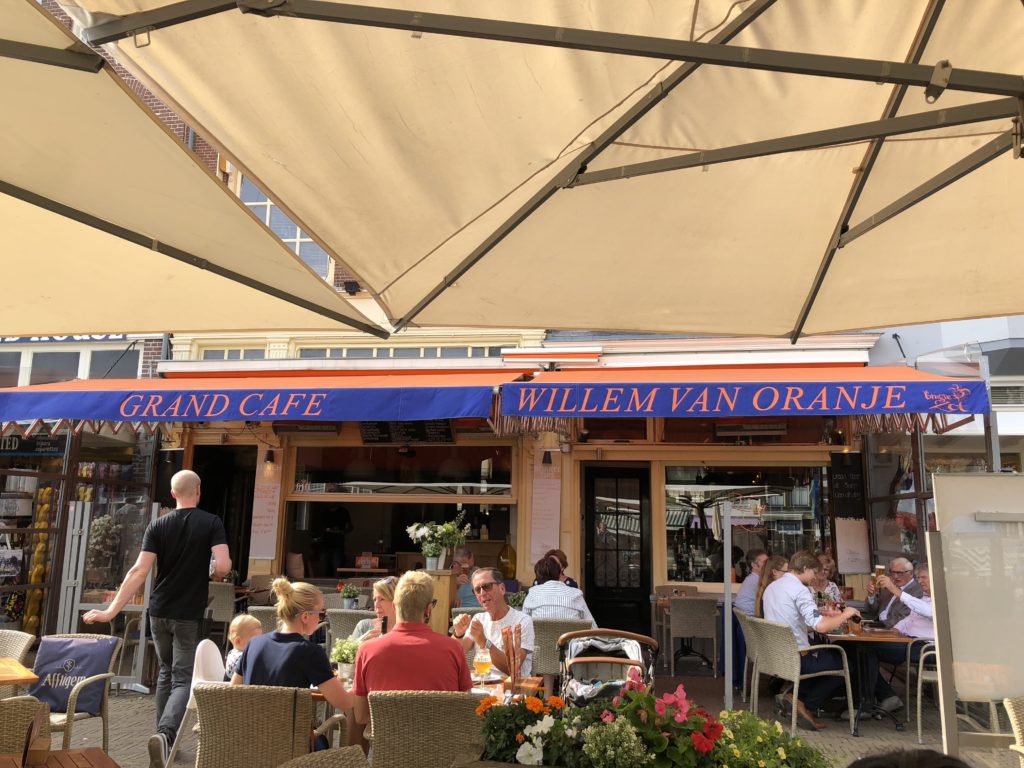
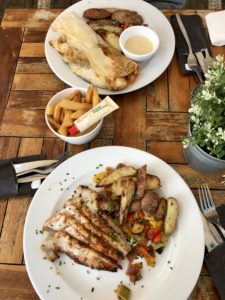
After returning to Amsterdam, some of us took a rest and started pregame for clubbing at around midnight. We each drank a couple of cocktails first. I did the Friday night special Fireball shots with another girl. After a talk about guys in the sofa—what girls always do together, two guys in our program joined us. We ubered together to the club called Air Amsterdam.
The club was middle-sized and very crowded on the dance floor. A black rapper sat on a tall chair right next to the black DJs, strIking the air with his arm. We took a vodka shot together, then squeezed through the crowd to get to the front of the dance floor. We didn’t drink much or smoke at all , but all got natural high as can be seen in our wild and free dance moves.
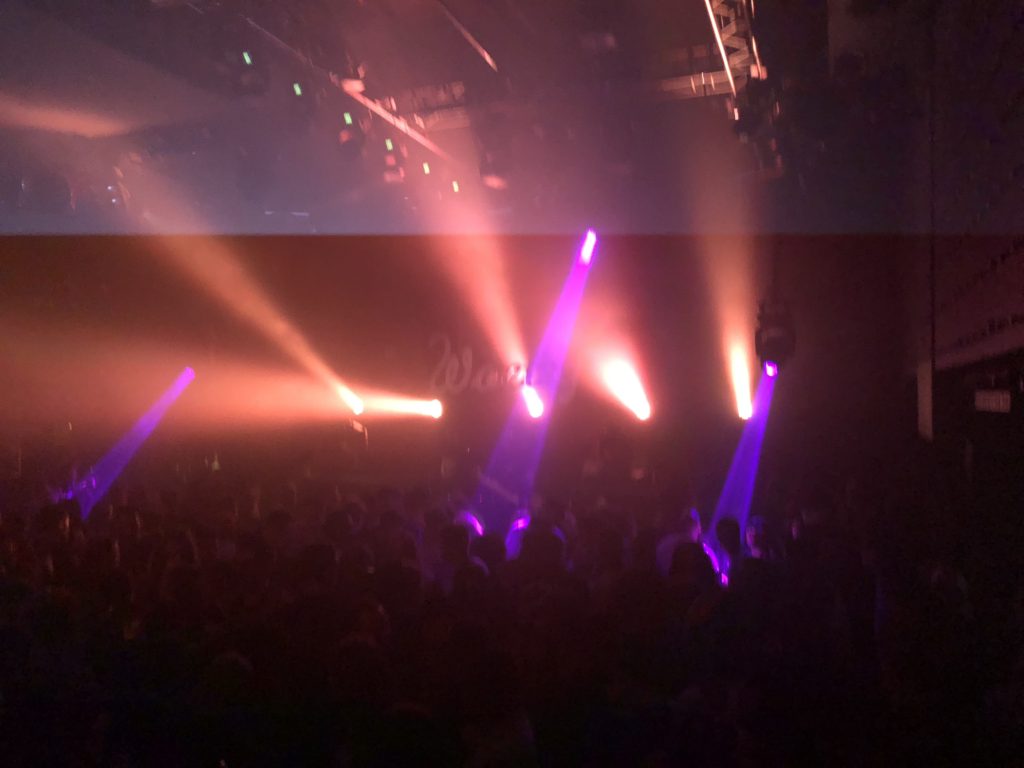
My original intention of going clubbing, despite of my exhaustion after a long day, was to observe and describe the unique qualities of clubs in Amsterdam, or even Europe in general. But I soon realized that they are all pretty much the same. The same type of desire for artificial and unattainable bonds with other people. Each think he or she has successfully become part of a cultural group, merging into the cultural trend. Yet deep down each has his or her own doubt of the self-fabricated purposes and connection of such a activity. The scene of the crowd is always a lonely and pitied tragicomedy all together. Human pursuit of transient bonding, intoxicant rollicking and frantic expression is all the same everywhere.
The nuance perhaps lies in the diversity of the clubbing group. Here you hear languages of all roots. Here you see skins of all colors. Here you smell perfumes or weed of all brands. Here your soul is temporarily muffled among all the rubbing and clashing of bodies with completely different forms and rhythmic movements.
Later, as we were waiting for our Uber outside at 4am, a robust Dutch man approached us. He pointed at the girls and said how much he would spend for which of us. Olivia told him to leave straight off. Then he became more playfully aggressive and called his friends to come too. He pointed to me at some point, asked me if I am Japanese, joined his palms and said hi to me in Thai. His friend put his arm around one of the guys in our group and said, “This guy is Harry Potter!” But later they left after a sober friend of theirs and an auxiliary police had intervened.
The man maybe drunk, but his intoxication can by no means be an excuse for his disrespect for women. And I wonder if that is part of the consequence of legalizing prostitution in a country? While the legalization protected the rights of sex workers, a sexualized and objectified image of female is also both constituted and constituting in the society. Could it be the reason why this man was pricing each of us with a despicable smile? Or should it be considered an individual case? Or is it just a ubiquitous mentality of men?
I lit a cigarette and looked along the canal on the bridge. The smoke was blown right to my face by the wind. The shades of houses and trees along the canal dropped unto the water surface, strewn with the flickering dots of yellow street light. A small boat cut the water in half and came toward us. The two men on the boat yelled something to us right before getting under the bridge.
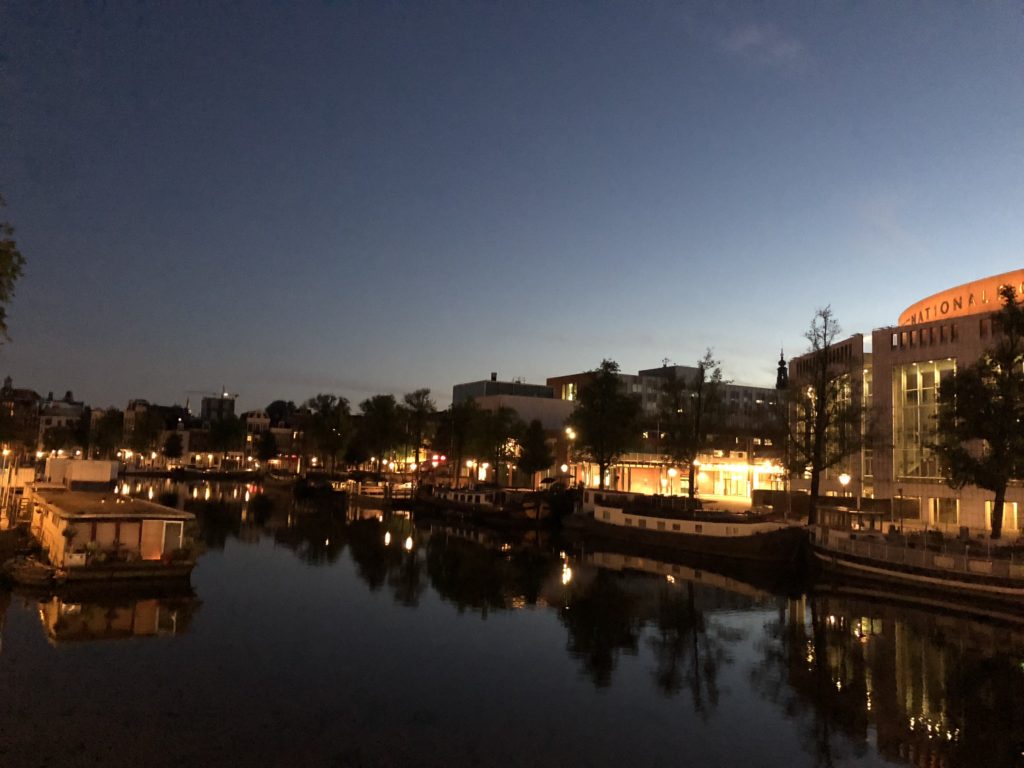
The sky was only slightly lit. But the night was very lit.
2018.7.7 Day 7: Stedelijk Museum, Sex Museum, Red Light District
I went to bed at 5 and woke up at 8. My friends are amazed at how much energy I still have despite of the lack of sleep.
In the morning, I went to the Stedelijk Museum with two other girls. Stedelijk is definitely one of the best modern art museums I have ever visited.
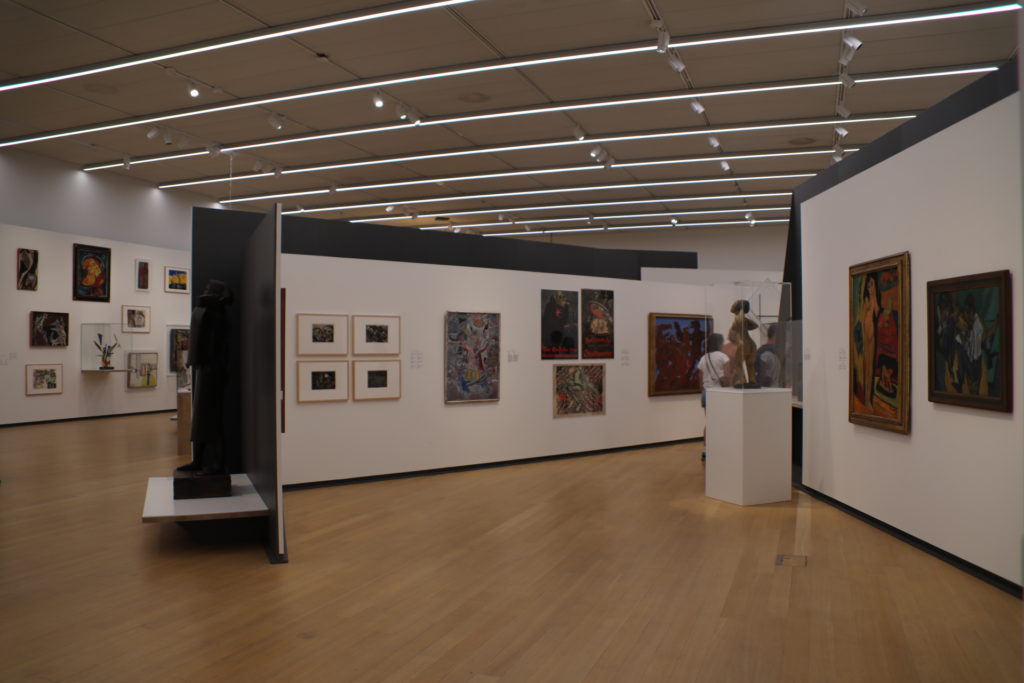
Among the amazing Stedelijk Base collection of 1880-1980 artworks, “The Beanery” by Edward Kienholz is my favorite one. It is a reconstruction of a real Los Angeles bar, Barney’s Beanery. Made in 1965, this interior of the walk-in installation is an exact replica of the original bar at the time. Next to the entrance is a copy of “Herald Examiner” from 1964, with the front page covering an article titled “Children Kill Children in Vietnam Riots.” Once walking inside the bar, the harsh music playing in the background is a recording made by Kienholz himself of the real bar music. The mixture of scents of cigarettes and alcohol is regularly made according to the artist’s own recipe.
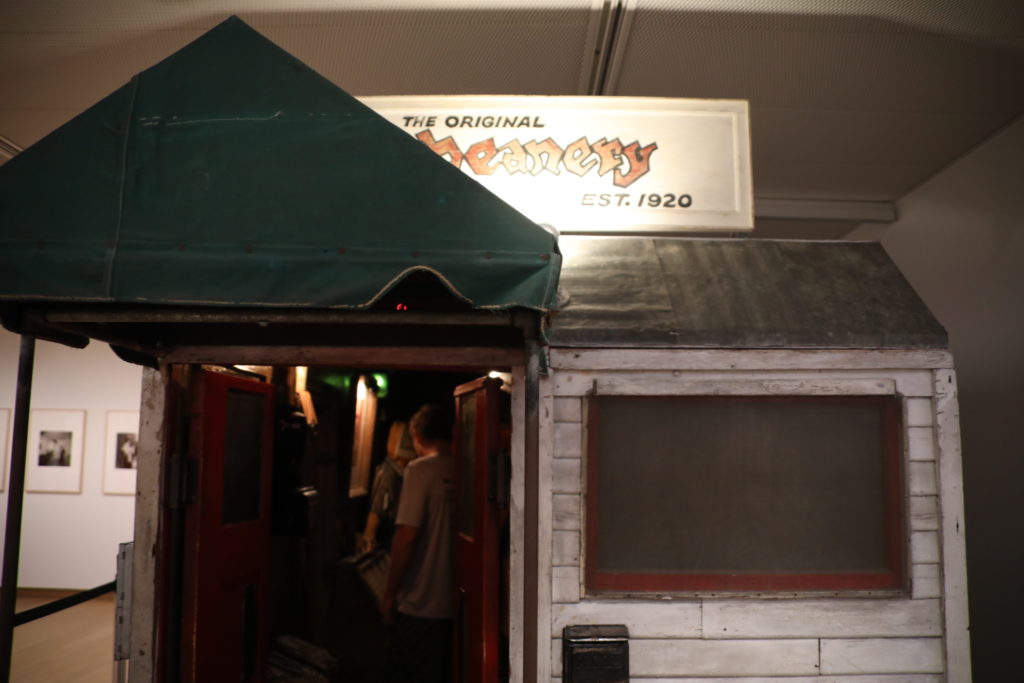
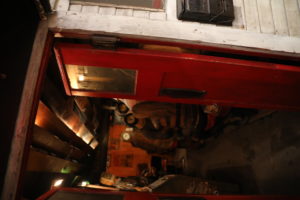
All customers have clocks for faces, always reading 10:10. While the time outside is passing quickly, the time in the pub is subjective and standing still.
Kienholz is quoted as saying “The entire work symbolizes the switch from real time (symbolized by a newspaper) to the surrealist time inside the bar, where people waste time, kill time, forget time, and ignore time.”
I talked to the young woman supervising the entrance of the installation. She asked me how I felt after entering the simulated bar. I told her I felt sad that these little fragments of history are lost to time and forgotten, but I was amazed by the fact that the artist was able to preserve a piece of time in the past so well.
“That’s right. But these moments are recurring all the time. This artwork alludes to the anxiety and restlessness of a prewar generation in the 20th century. But now there are wars going on in other parts of the world. The same kind of human commotion is happening now.”
We talked a little bit more about the illusionary bubble we live in, and I went on to the next exhibition hall.
I also really enjoyed the work of Studio Drift, which sits at the interface betweentech art, performance and biodesign. It focuses on the changing relationship between human beings, nature and technology.
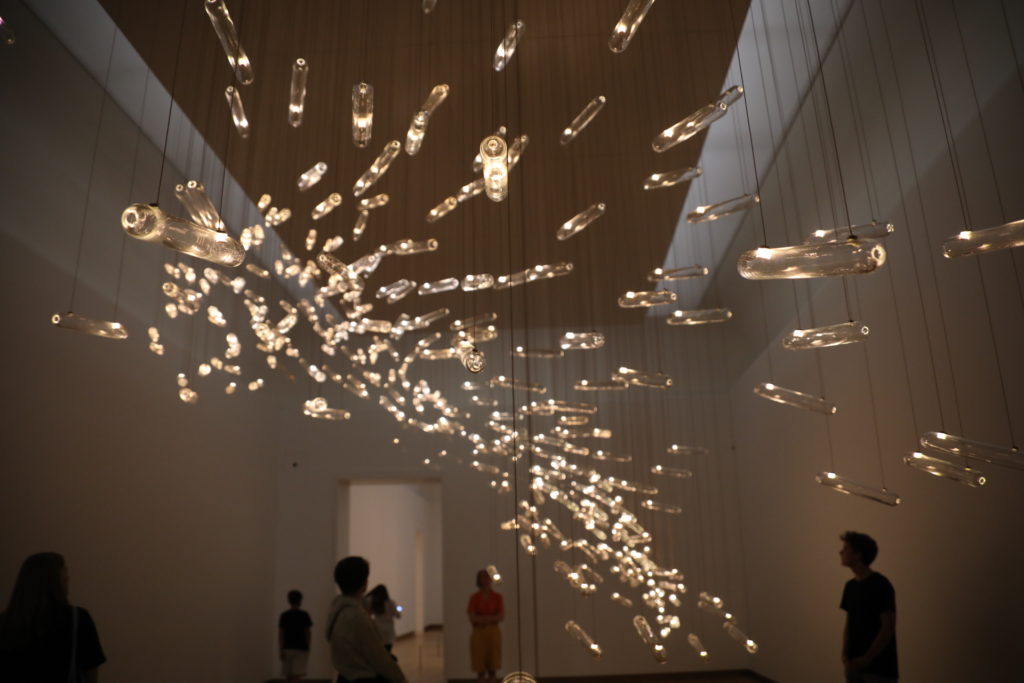

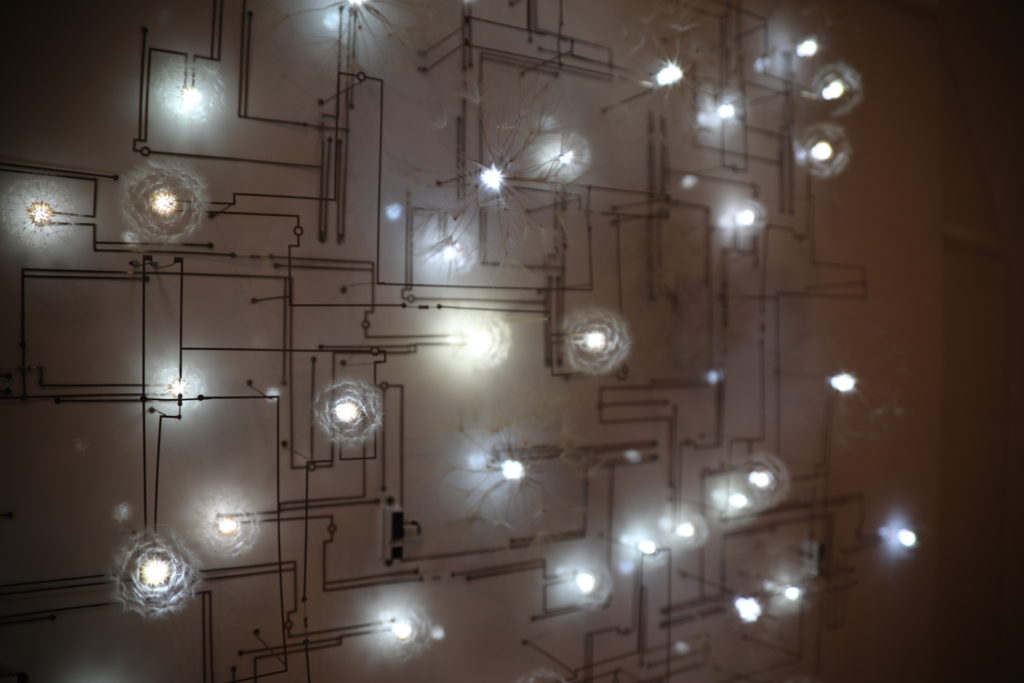
One of the installation is called Fragile Future, an series of light sculptures of dandelion heads individually applied to LED lights. The work evolved into a system composed of modules and can be combined in various configurations. The extremely labor-intensive process of gluing the dandelion seeds to the LEDs represents a stark contrast, between the exacting craftsmanship and today’s mass production processes. It also offers a utopian glimpse into a future in which these two seemingly irreconcilable forces unite together under human efforts.
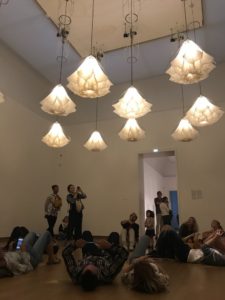
Shylight is an installation of a series of lights that unfolds and retreats in a fascinating choreography, imitating the vivid movements of real flowers. It is inspired by a natural mechanism is called ‘nyctinasty,’ the behavior of flowers closing at night for self-defence and conservation of resources. I lied down on the ground and watched the moving lights from the bottom, losing myself to their silent but powerful languages.
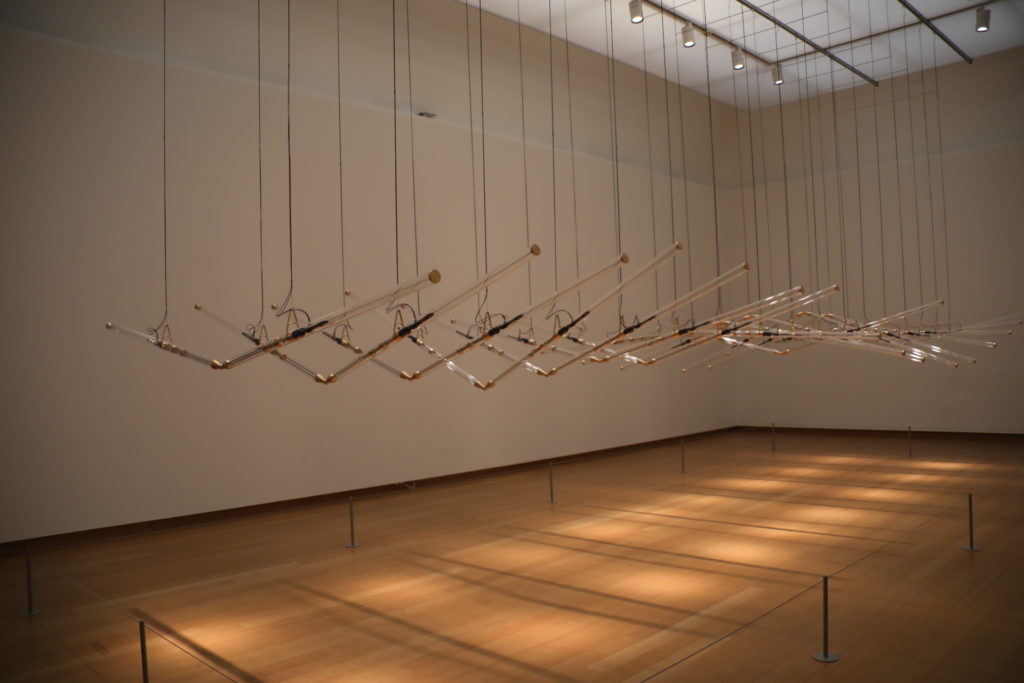
Amplitude is a collection of light tubes synchronized by a computer. The movement is like the pulse that occurs in all living nature, triggered by a weight that slides back and forth in the tube. Watching the light tubes gives an impression of watching a bird flying in slow motion.
All the installations produced by the Studio Drift gave me an illusion of breath and life in the “lifeless” objects. They raised a lot of questions in my head. Where is the border between nature and life, living and lifeless? Is there a difference between the real and the virtual world?
All the work in the Stedelijk Museum also make me wonder about the way artists perceive their own realities, and how each of us should perceive our own realities. If we see reality as exactly how it appears to us, then reality becomes very boring indeed. We only see the surface of the water with hydrophobic eyes, without ever being able to put our head into water and see what is beneath the surface. There is obviously a risk of drowning if we do that. Yet the fun of reality, the imaginary symbols and subjective images associated with it, lies deep in the water, waiting to be discovered only by those risk-takers.
After leaving the Stedelijk at around 2, we ate lunch at the Seafood Bar. We then rented three bikes. They had difficulties in riding the bike and had to practice in the park first, so I rode to the Nine Streets to do some shopping by myself. I was greeted by a gay Dutch guy in the first clothes store I went in. After we chatted about the sunny weather for a bit, he told me with a high-pitched voice that he loved my smile. He even helped me take pictures after I changed into a black dress with “Brutal Love” written on it. As I was posing for the pictures, he said he loved how I was all energetic and sunny and not shy at all, unlike most Asian girls. He even wrote down his name and number on my receipt and a couple of restaurants that the locals always go to. One of them is called Happy Happy Joy Joy.
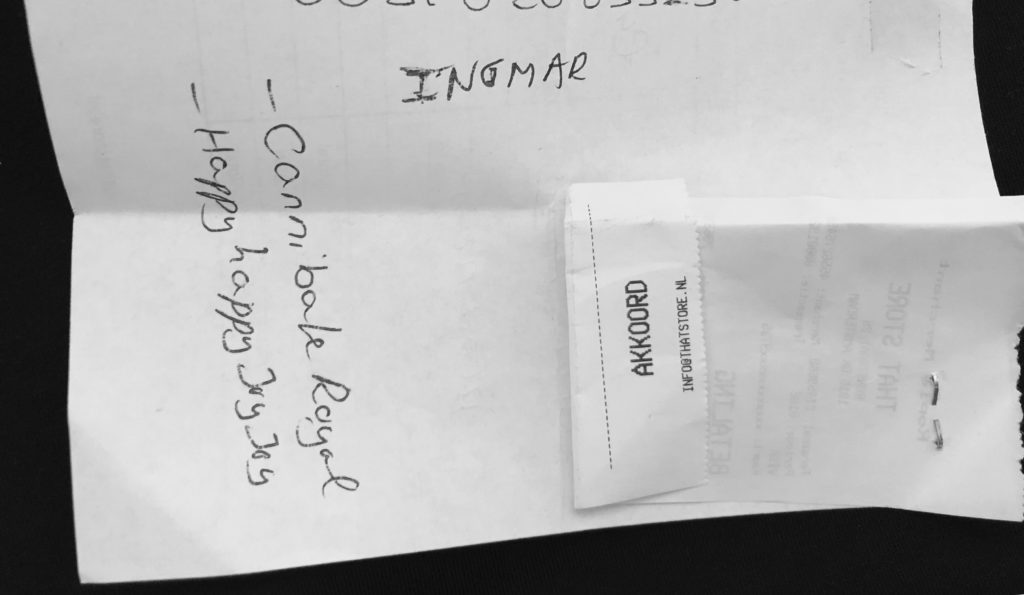
After being labeled as a shy and quiet girl during high school, I feel so liberated that I have finally transformed into who I really am. I have finally liberated my inner self and opened my heart to others. I have become even more so in a foreign land, where no one knows who I am and therefore no one has any biased preconceptions of me. I can be whoever I am here! It feels so great!
Later I met up with the two girls near the Central Station. The area in the city center doesn’t at all resemble the nice and cozy neighborhood around the Museum Square in the south. The streets are messy, dirty and crowded with loud and rude visitors, somehow reminding me of the Time Square in New York. The trams, buses and local bikes ran about madly on the streets, never slowing down and always seeming indifferent to the life of anyone else. The scene broke my projection of the Netherlands as one of the most cozy and fairytale-like countries. Dirtiness and indecency exist everywhere.
We went to the sex museum together, which is apparently a very popular tourist site in Amsterdam. As you have probably imagined, you will find countless sexual images, poems, statues, paintings, installations and artifacts here.
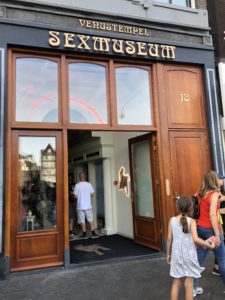
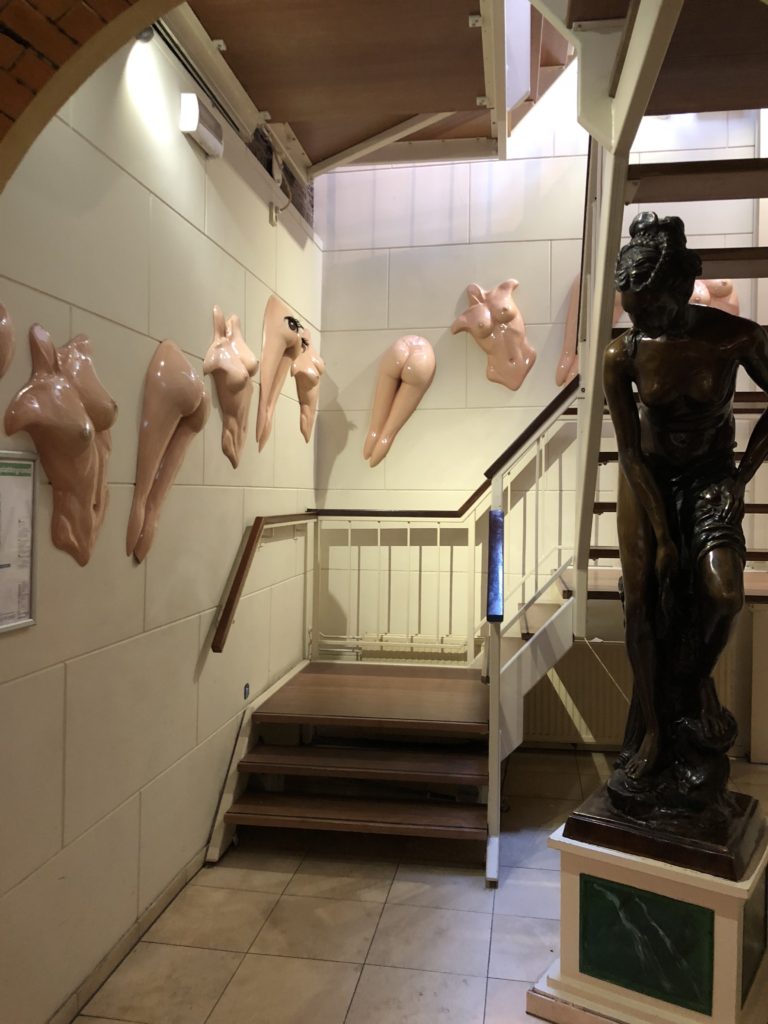
But I don’t find it worth going. Depicting sex as a violent and obscene activity is not hard at all. Just expose everything blatantly and those who searches for a visually sexual excitement will become the satisfied audience. But what is truly difficult is capturing the subtle beauty of sexuality. Only real artists can capture the flirtatious ambiguity of body-touching, the exchange of soul while tongue-kissing, the identity-merging reached by intercourse and so on. But I guess this is not the goal of the Sex Museum at all.
After having dinner in a Italian restaurant nearby. We walked to the Red Light District at around 9pm.
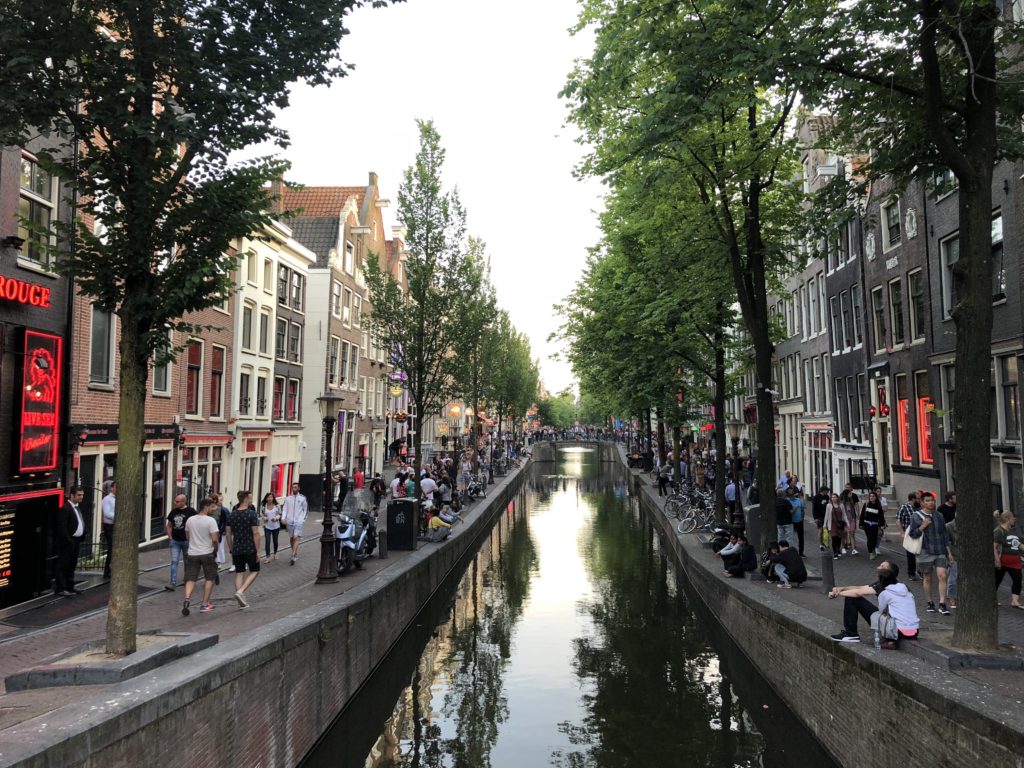
Amsterdam embraces the fact that people may be into prostitution, soft drugs or pornography with a very liberal and tolerant attitude, and prides itself for such tolerance. Instead of criminalizing everything, they enjoy the honesty of it all.
The name of “Red Light District” comes from all the red neon lights lining the hundreds of big glass windows behind which prostitutes work. Since nowadays prostitution is legal in the Netherlands but not on the streets, all prostitutes stand up behind the glass window and have their own bedroom, wearing as little cloth as possible.
On the streets you can find everything sex-related: sex shops, strip clubs, peep shows, sex theaters, Museum of Prostitution, Museum of Erotism, Museum of Cannabis, hippy condom shops and Dutch coffeeshops.
The first woman we saw wore a black G-string and kept shaking her plump buttocks while playing her phone. She casually casted a few indifferent looks to the men staring at her down on the street and smiled to them. As the sky got darker, more women appeared behind the windows. Some of them kept licking their lips and tapping the glass with fingers to tease and allure the men. All of them had the same indifferent facial expressions on their faces.
In fact, what creeped me out and disgusted me was not the sex workers, but the men on the streets! The streets were full of disgusting men doing nasty things! Some of them were secretly taking pictures of the women behind windows on the other side of the canal, even though pictures of sex workers are strictly prohibited here. Some of them yelled obscenity across the glass and then laughed about it with friends. Two Asian middle-aged men, probably visitors, kept staring at my friends and I with lopsided grins. One man, with an Italian accents, walked toward us and yelled to us how he loved watching the women. A tall men with red eyes opened the door to a transgender prostitute and teased her, getting kicked out a few seconds later for refusing to pay. Another man wearing a suit came to us from behind and asked us where we are from.
I don’t know how people actually feel about the sex culture in Amsterdam, which I don’t intend to judge at all. However, with an aesthetic mindset, I dislike its expression of sexual desires. For me, the blatancy mutilates the subtle beauty of sexuality.
Right nearby of the Red Light District is a lofty church. As we left the district, the church clock struck nine thirty. The sound of the clock was muffled by the commotion nearby, but my soul held on to the fading sound and felt soothed a little.
As we rode across the canals at midnight, I thought to myself: whatever Amsterdam is, it is definitely not a utopia. At least not for me!
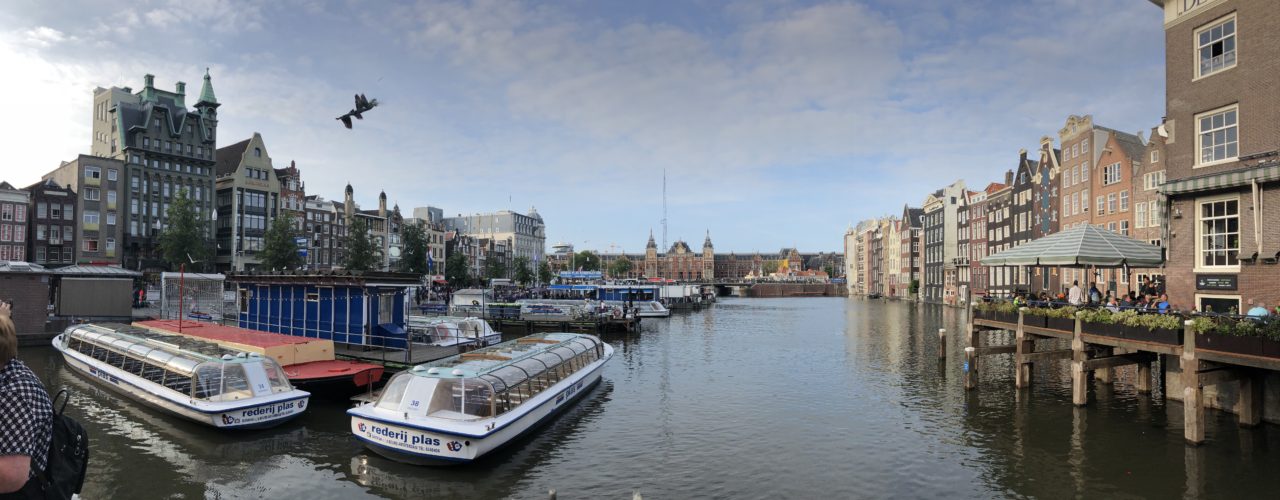
2018.7.8 Day 8: Arnhem’s Open Air Museum
Today, I took an one-hour train to Arnhem with friends.
Arnhem is on the eastern part of the Netherlands and is home to the Netherlands Open Air Museum, which we visited today. The open-air museum and park was full of antique houses, restored farms and open-homestead farmhouses from different parts of the Netherlands. There are also a beer brewing factory, a dairy factory, paper mills and linseed production machines, etc. On the polder, a few big traditional, building-like windmills rotated slowly against the blue sky. The park is so big that there are trams taking visitors from site to site.
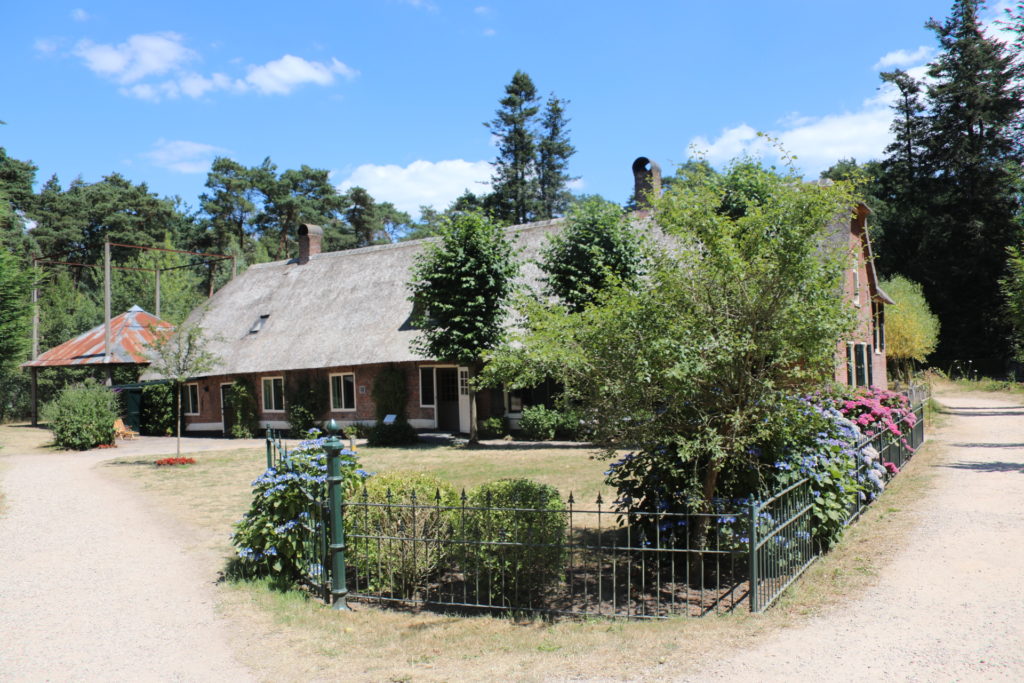
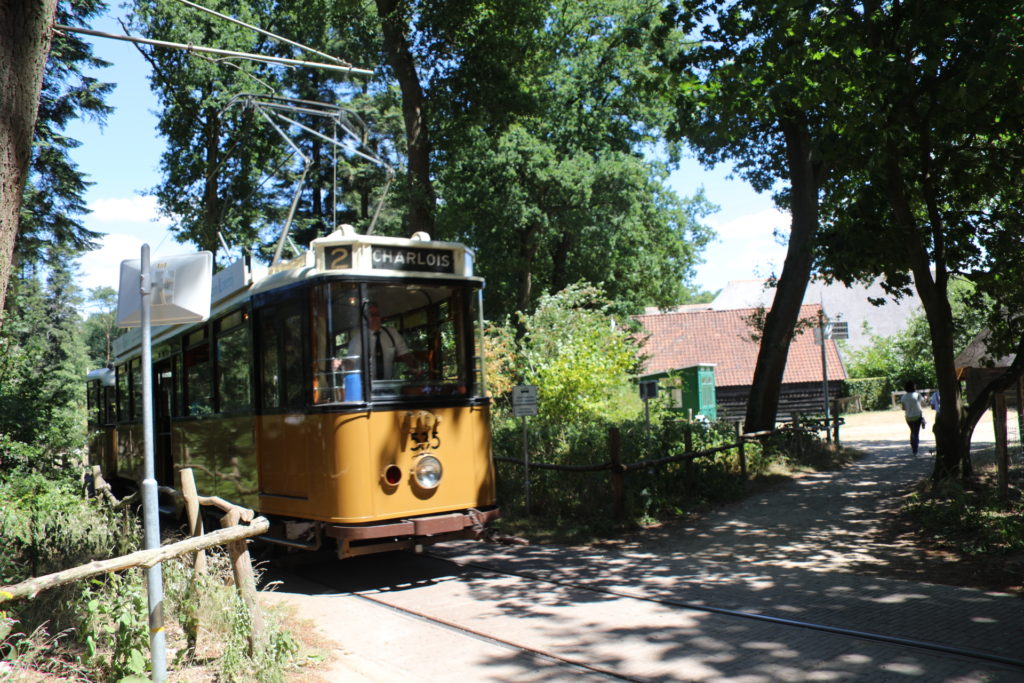
The exhibition displays the culture associated with the old everyday lives of the ordinary people. Living in a beautiful old building, amid the farmlands — that is the dream of many people. For some old inhabitants of the farmhouses, the dream became reality.

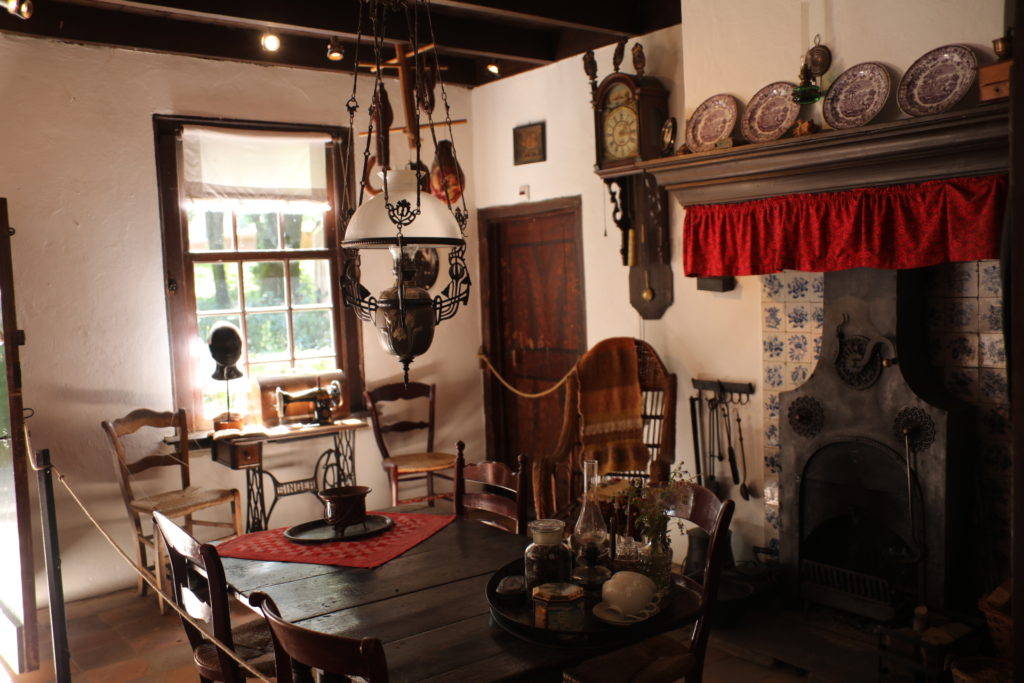
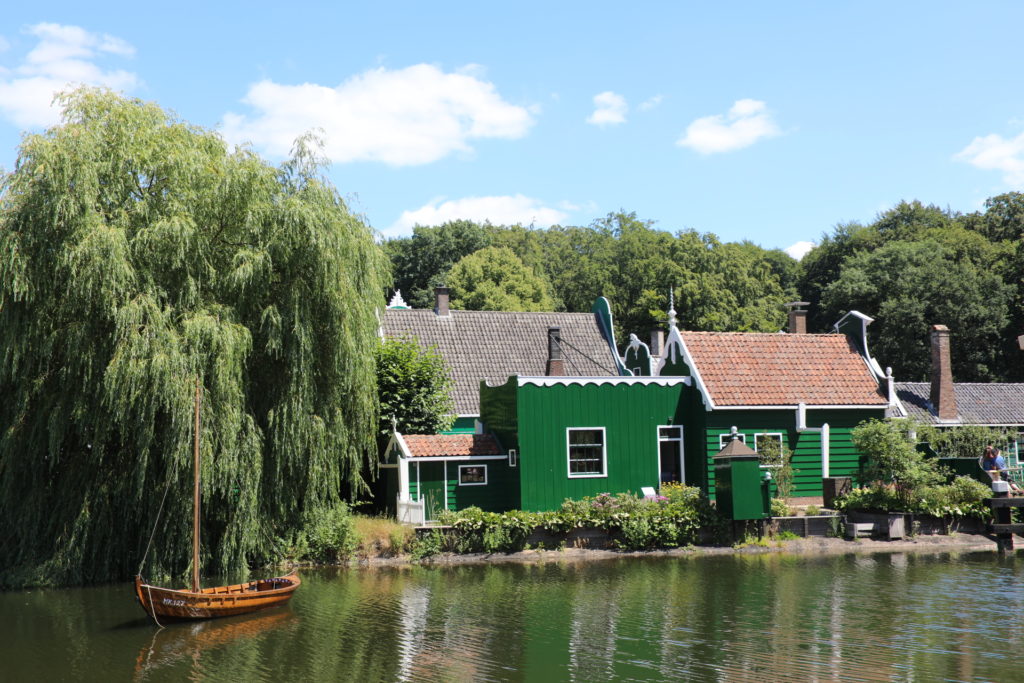
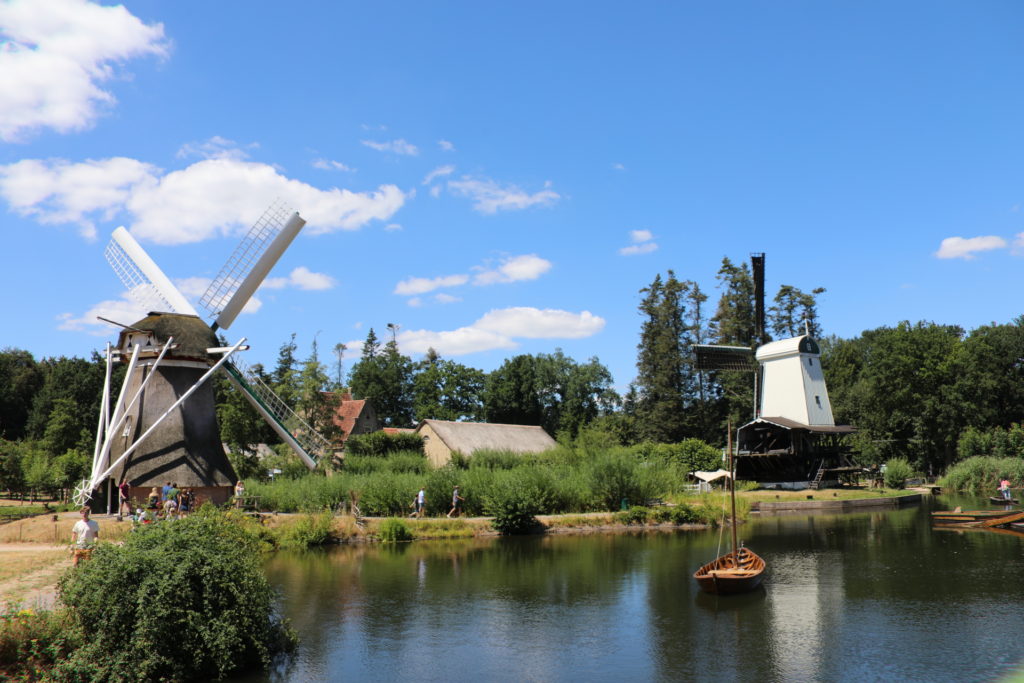
We skipped lunch. At around 3, we felt hungry, tired, sleepy and roasted under the scorching sun. We took the bus to get back to the Arnhem Central station and had dinner at 4 in a restaurant called Stan&Co. We got back to Amsterdam at 7. The trip was not as exciting as I imagined, but I am just so glad that I get to make friends with these girls and get to know them more day by day! I feel so relaxed and happy around them, even when I’m hungry, tired and sleepy!
After getting back to our room in the hostel, one of the girls began to talk about how art students like her often feel lost and confused about the future. The art community in Berkeley is rather small and mostly consists of people who are very different from her. Her conservative Asian dad always quarrels with or even jeers at her for the decision to transfer to art practice major.
Why bother doing something you hate just for an average salary and even more average lifestyle? I encouraged her to be proud of herself and continue doing what she loves. But I know that we cannot escape the inner doubt and confusion about our futures. This is the price of being young and wild!

